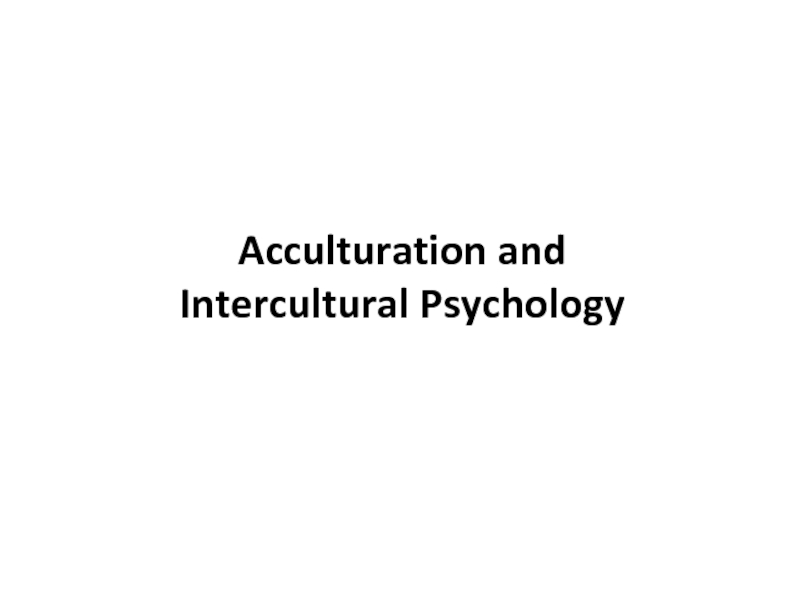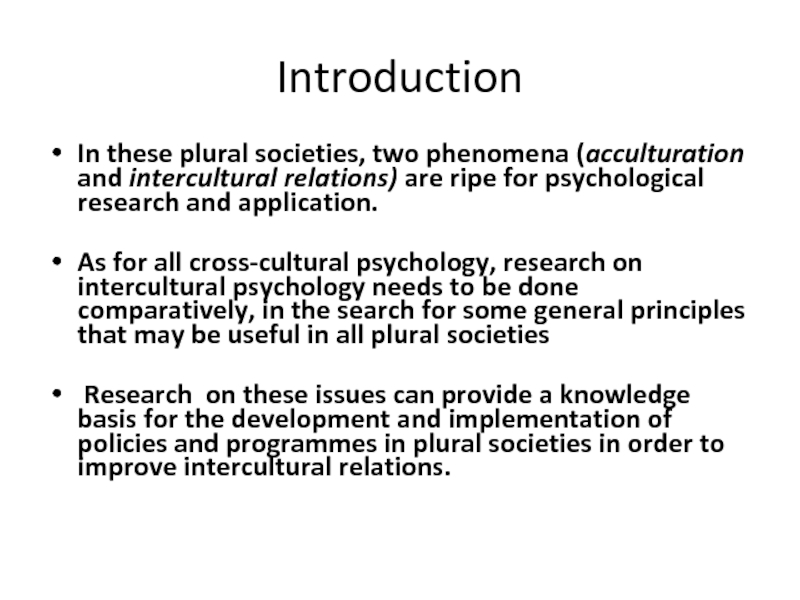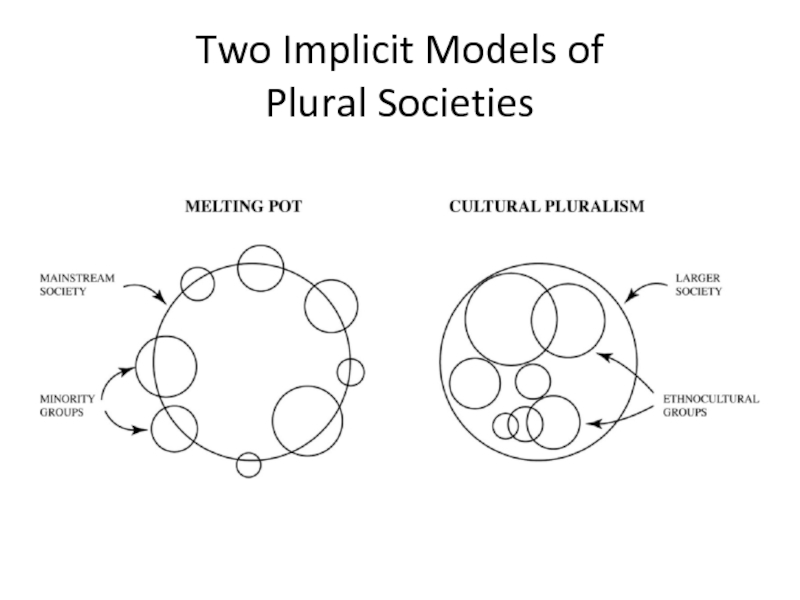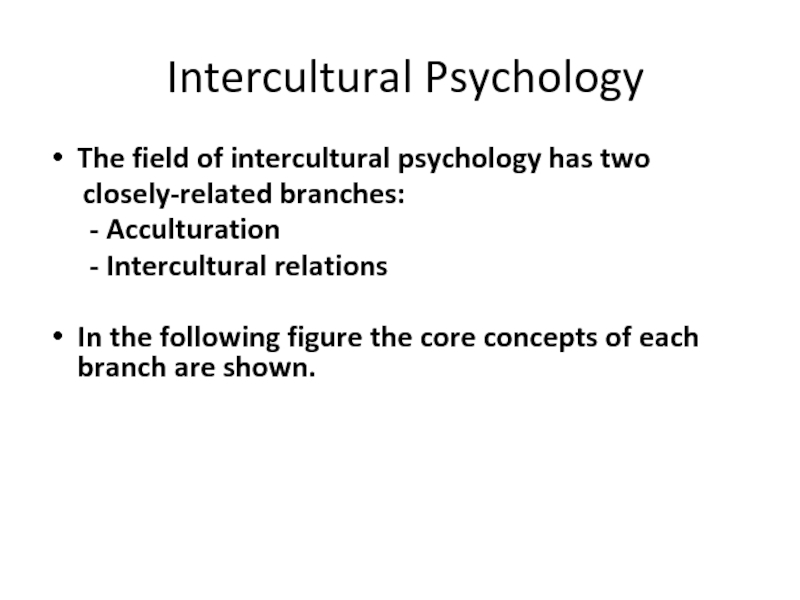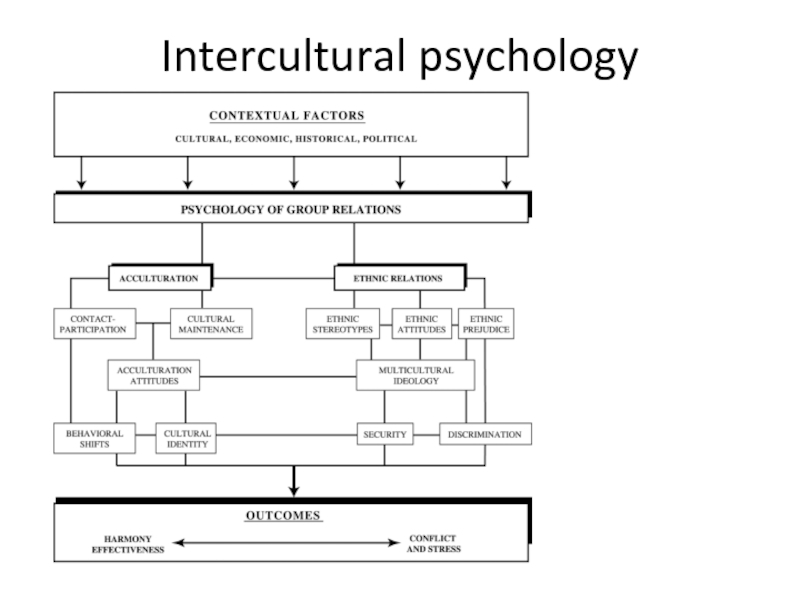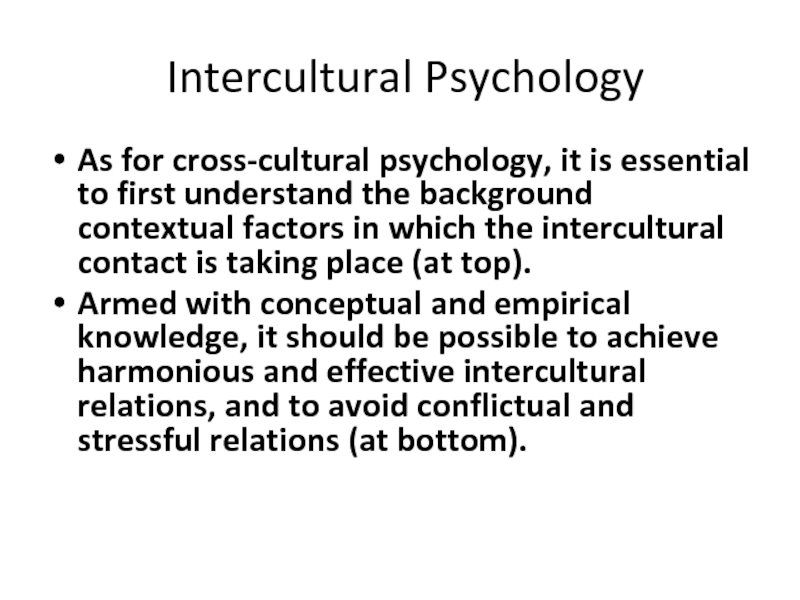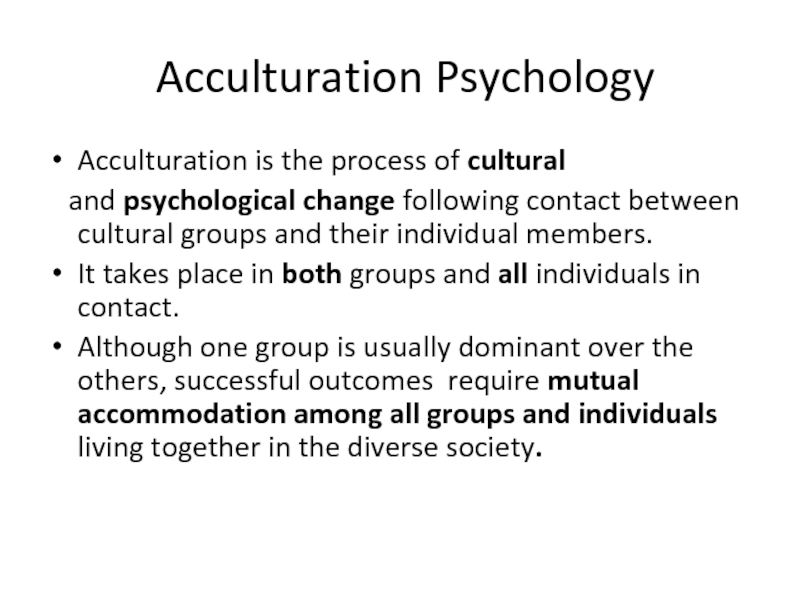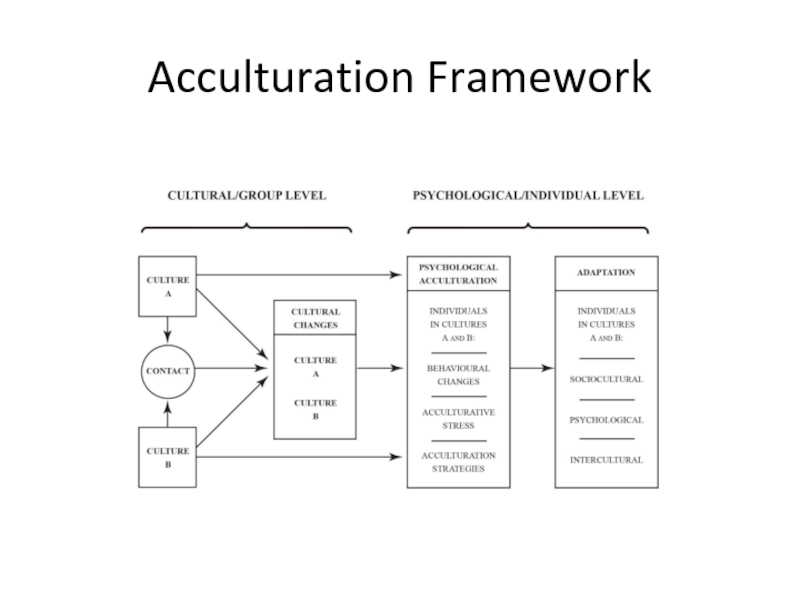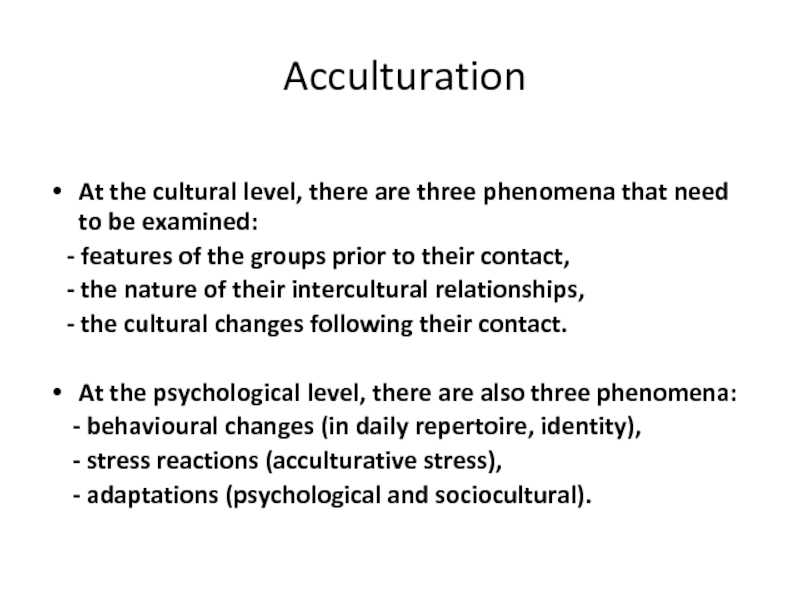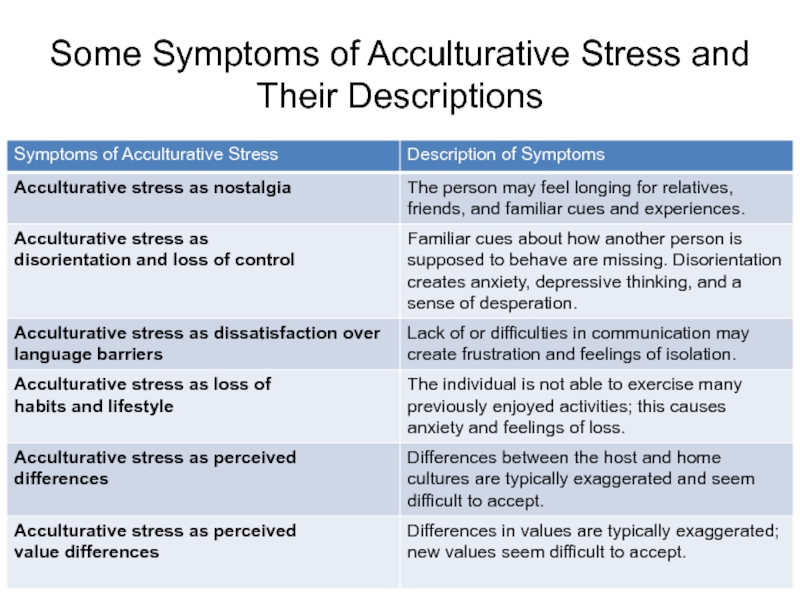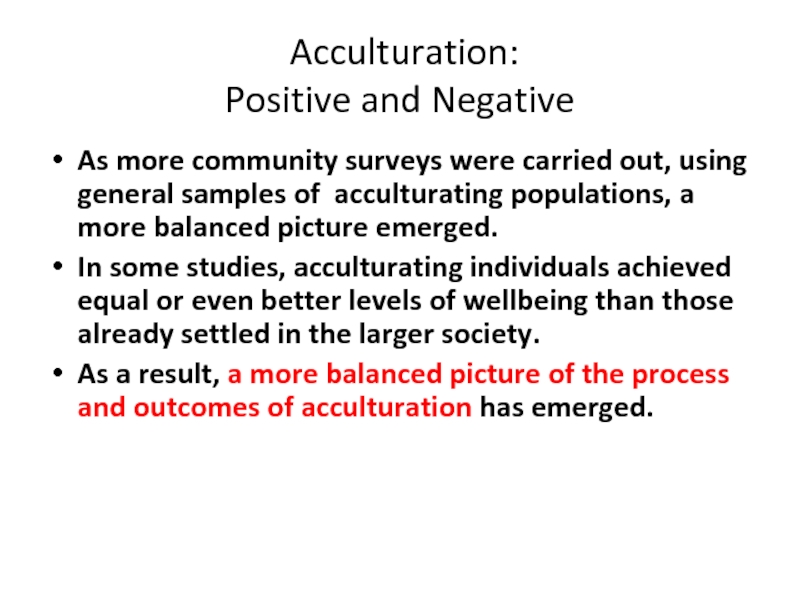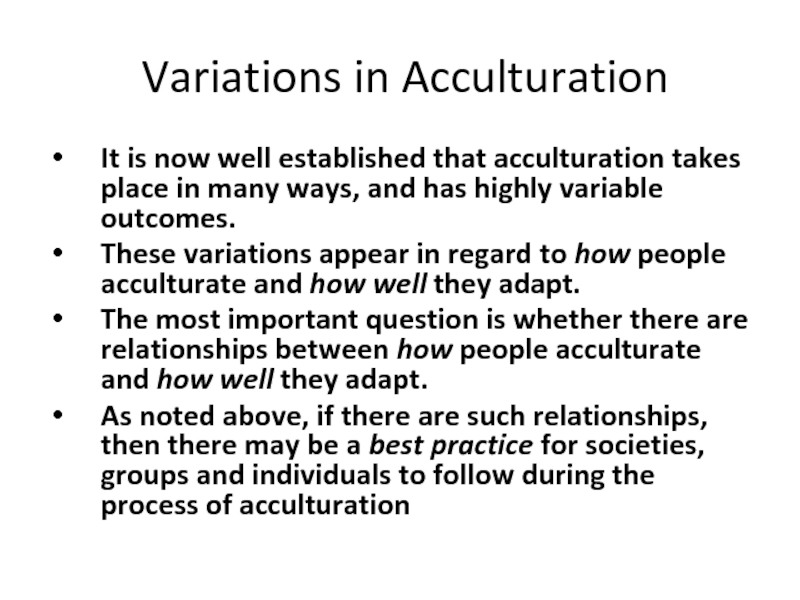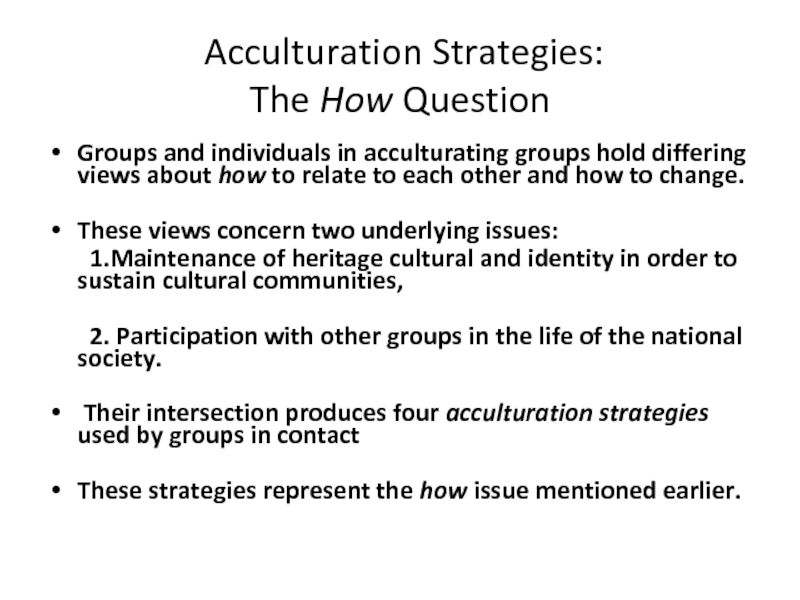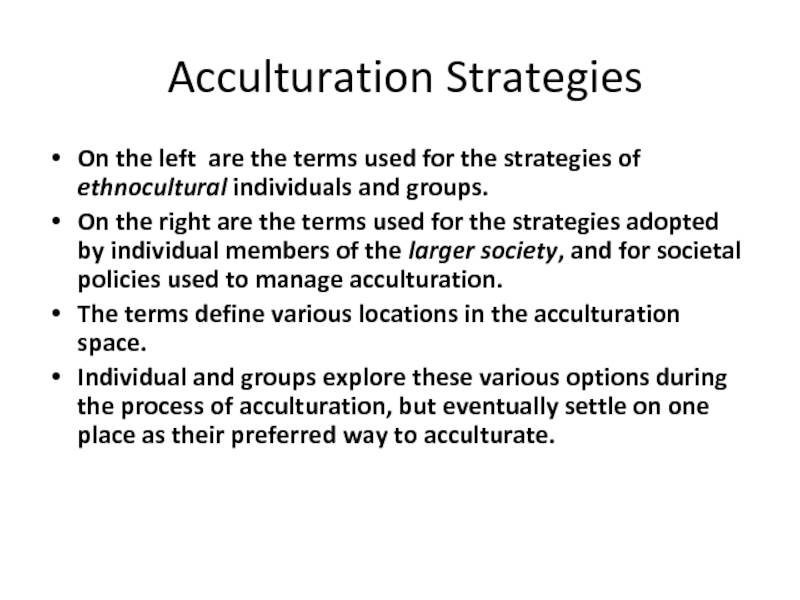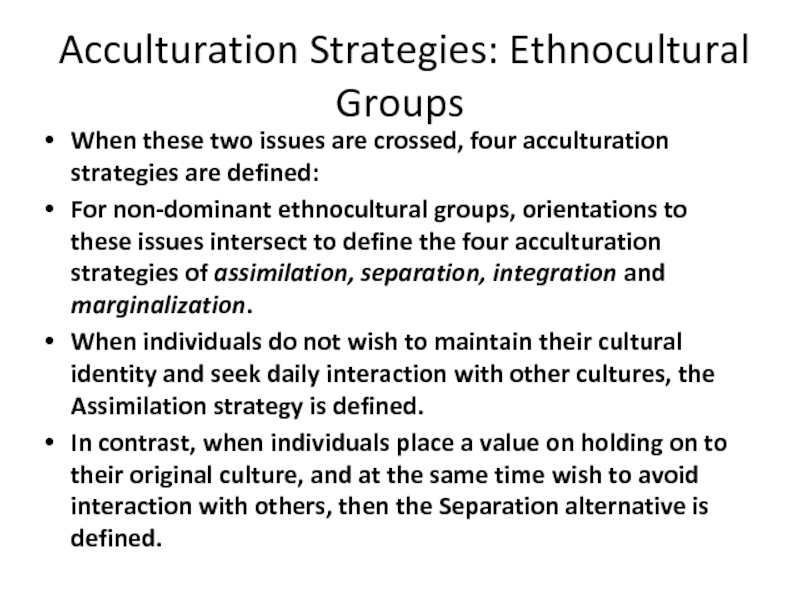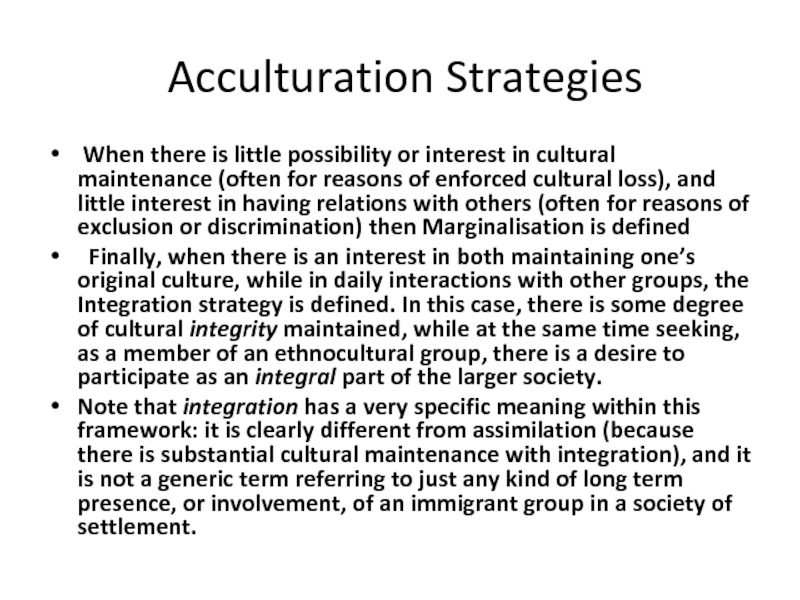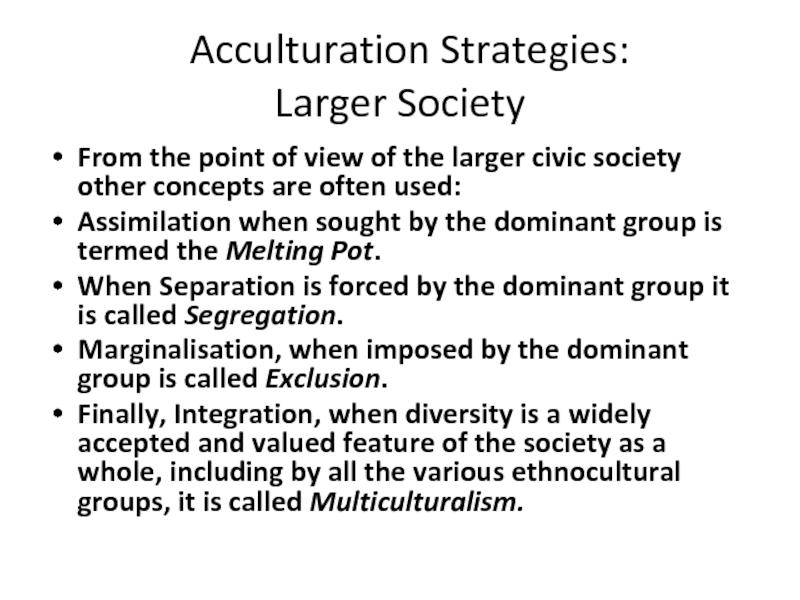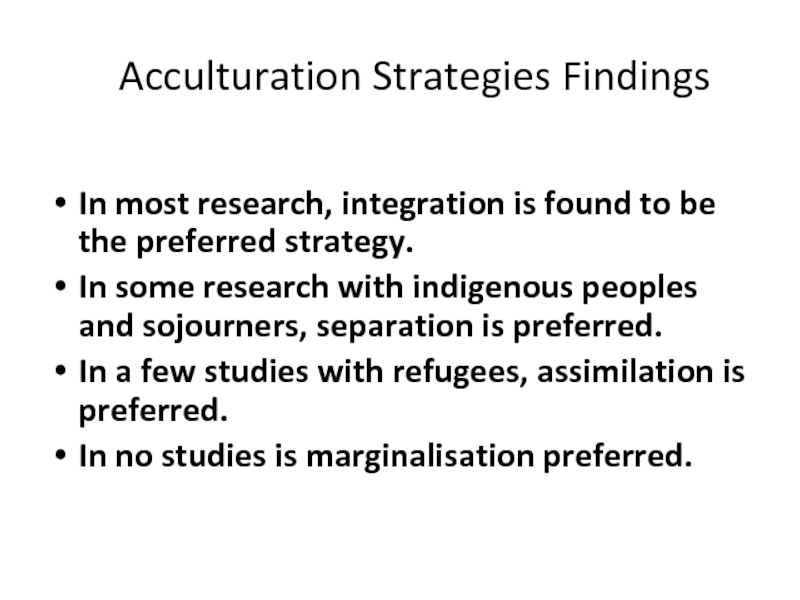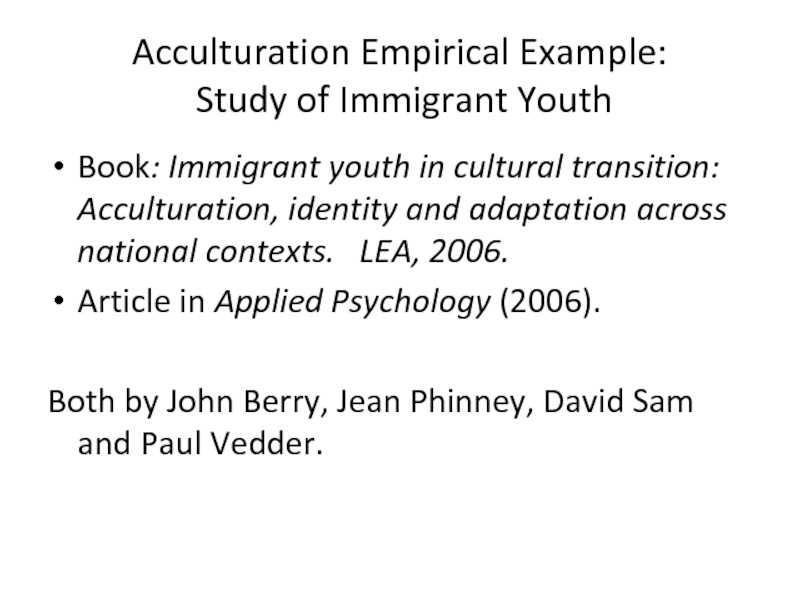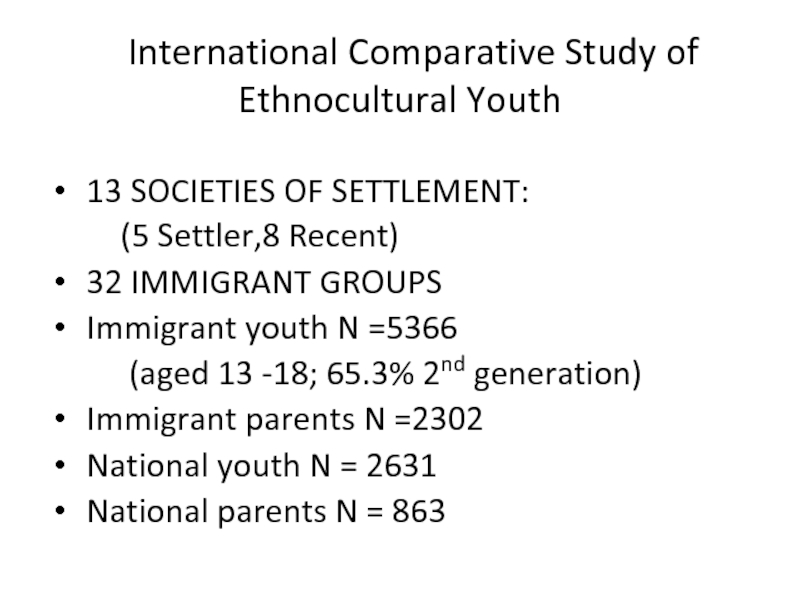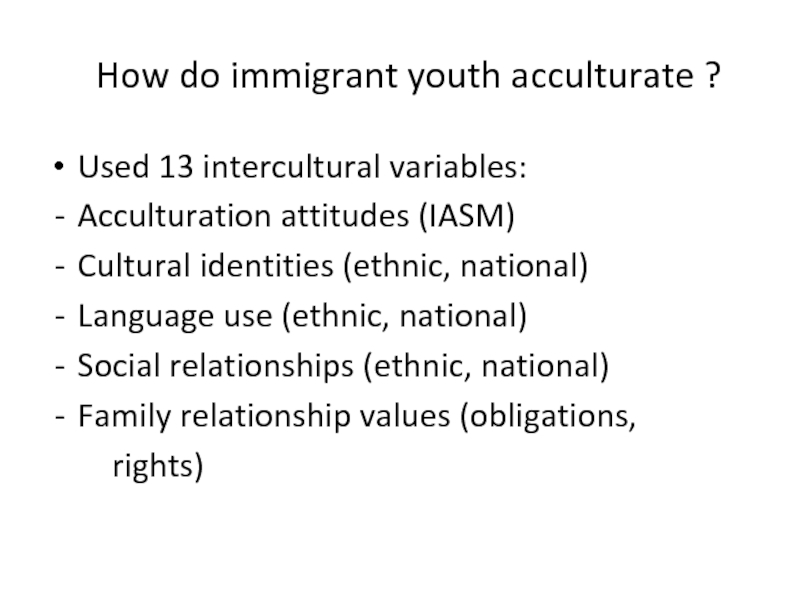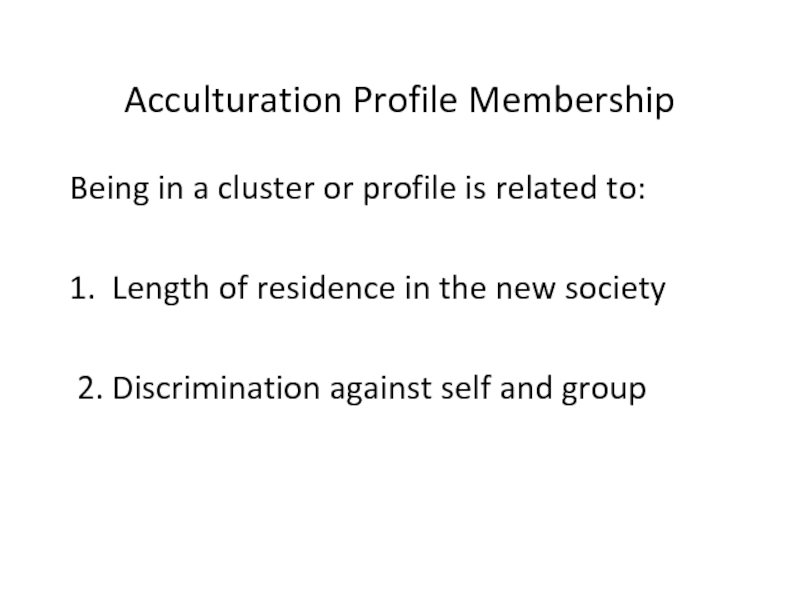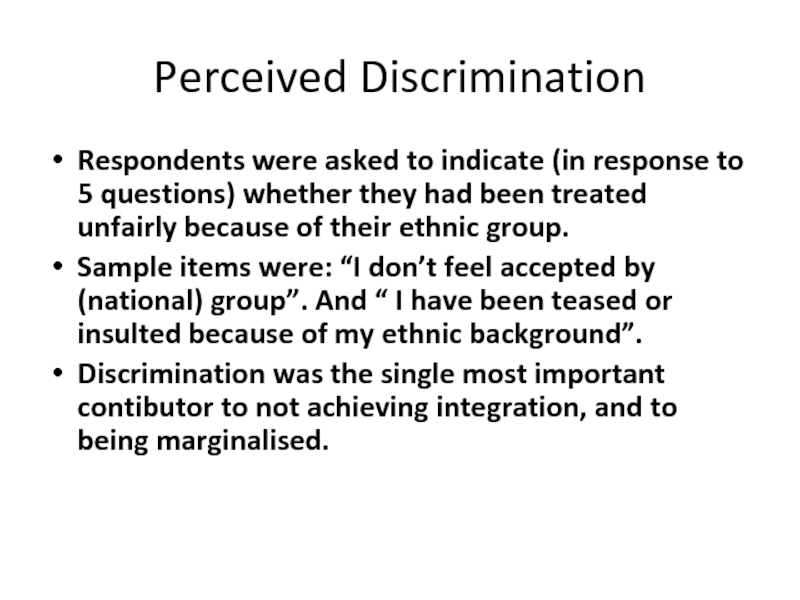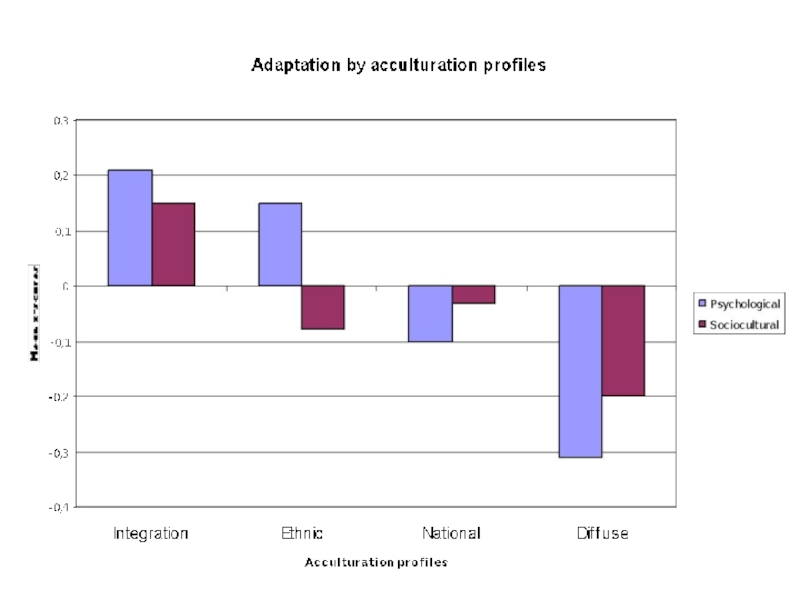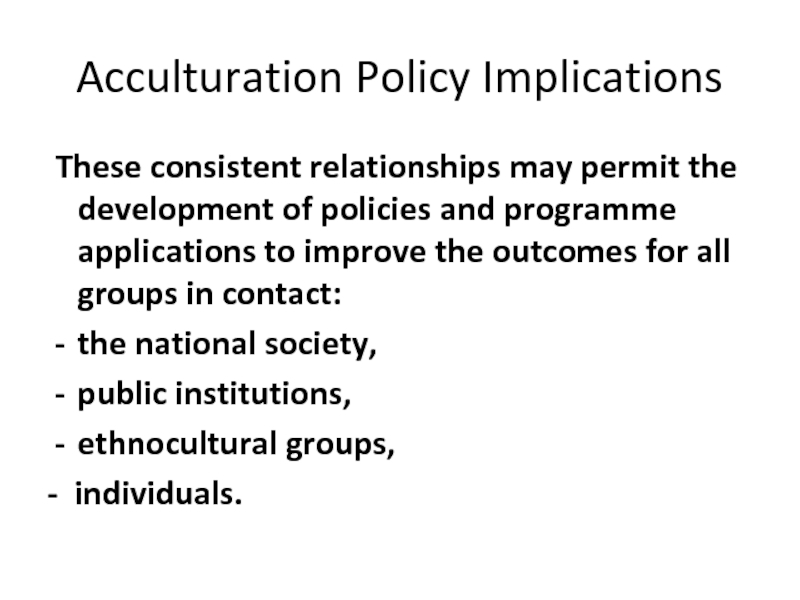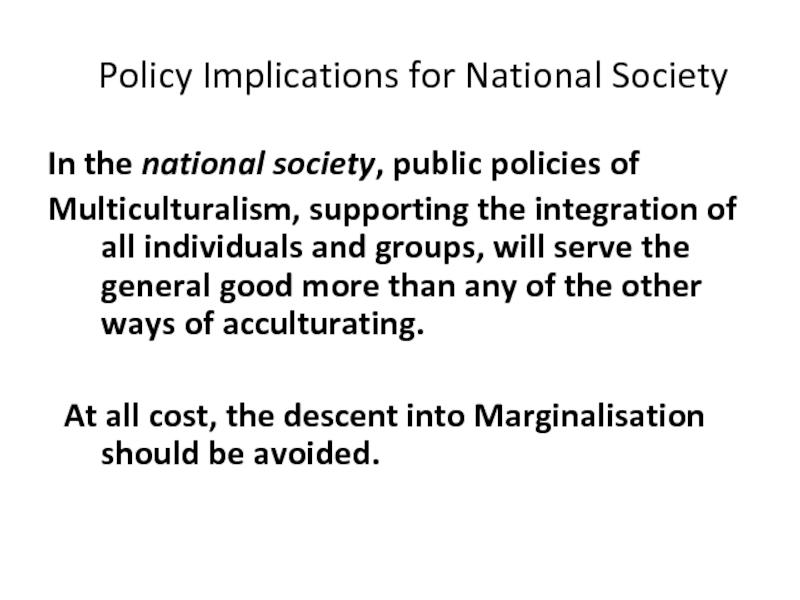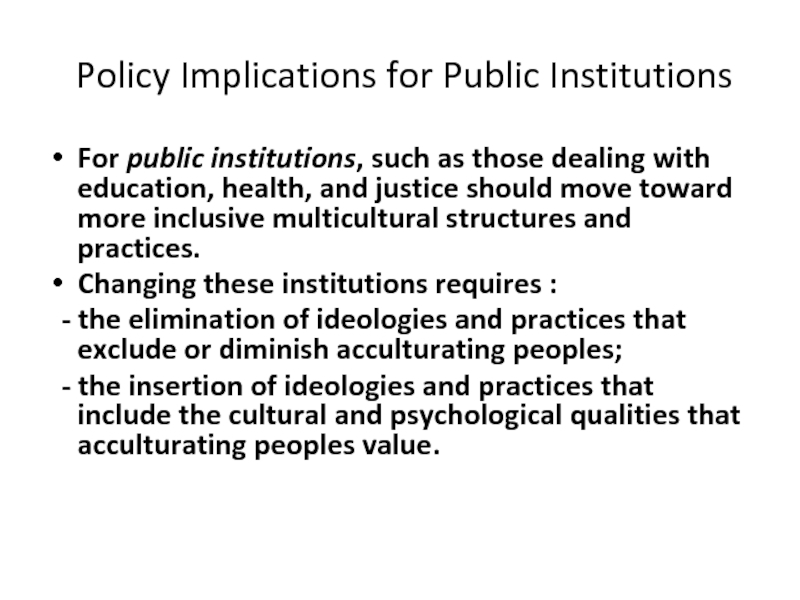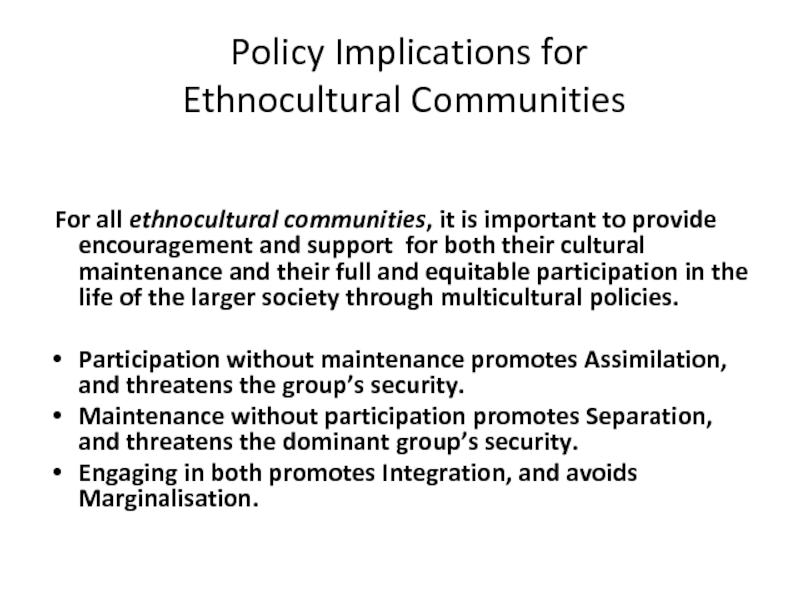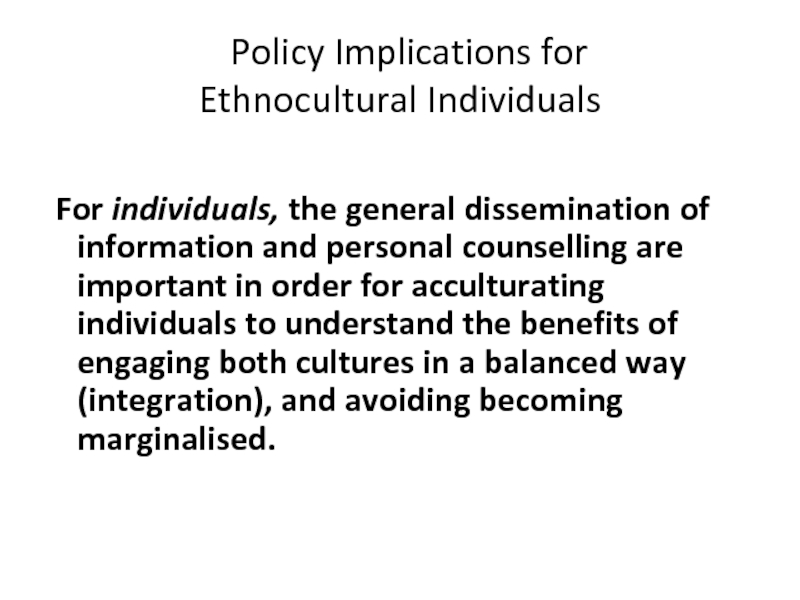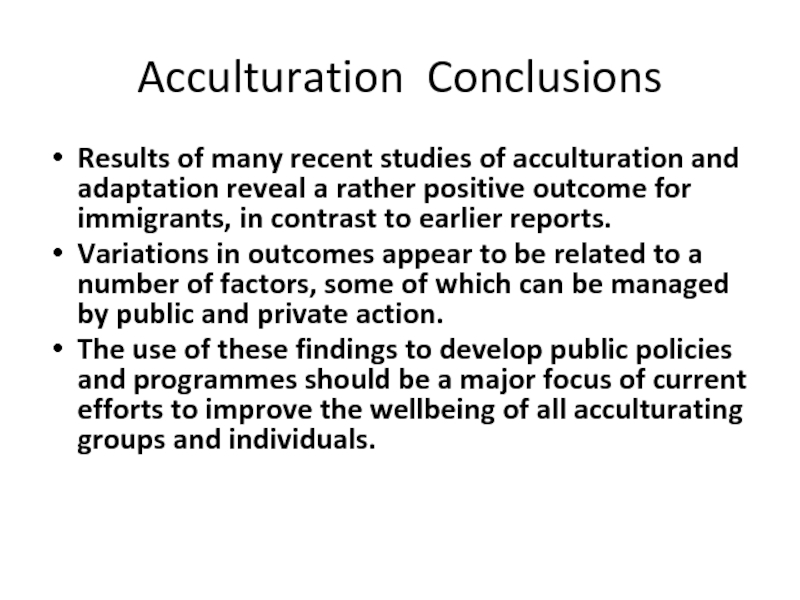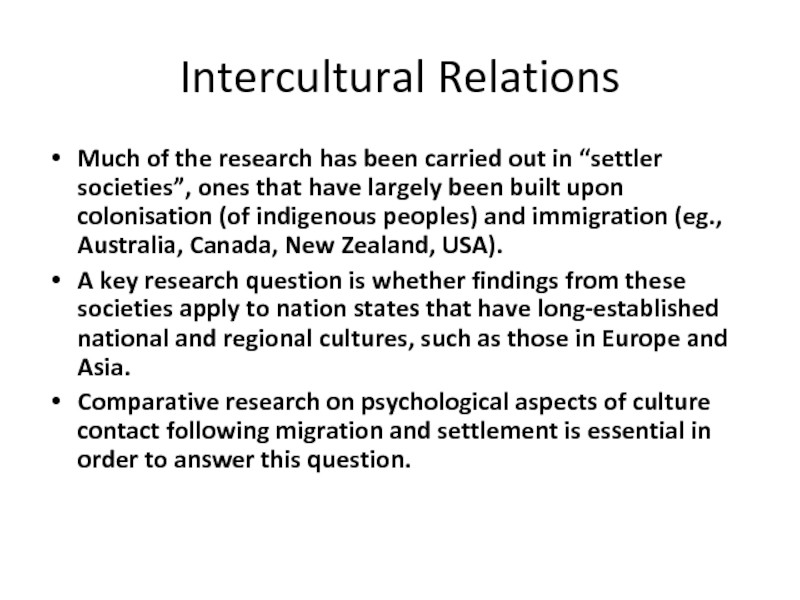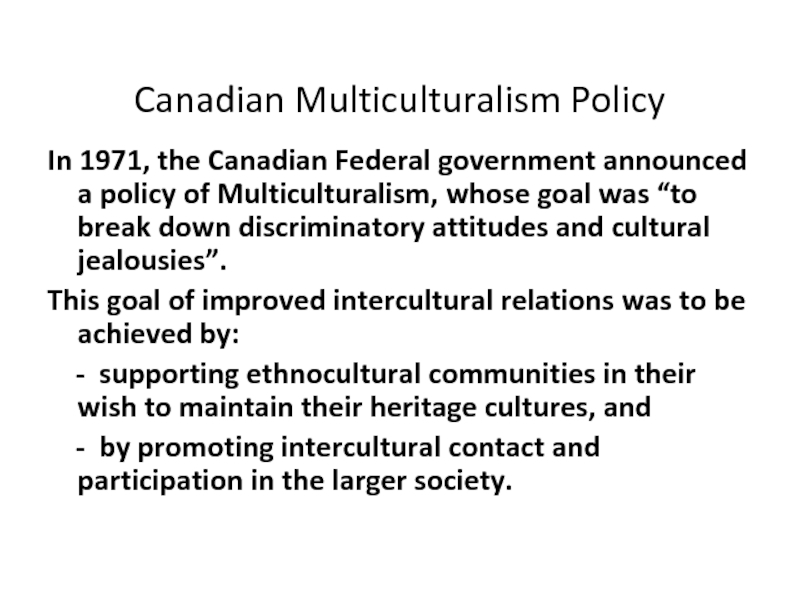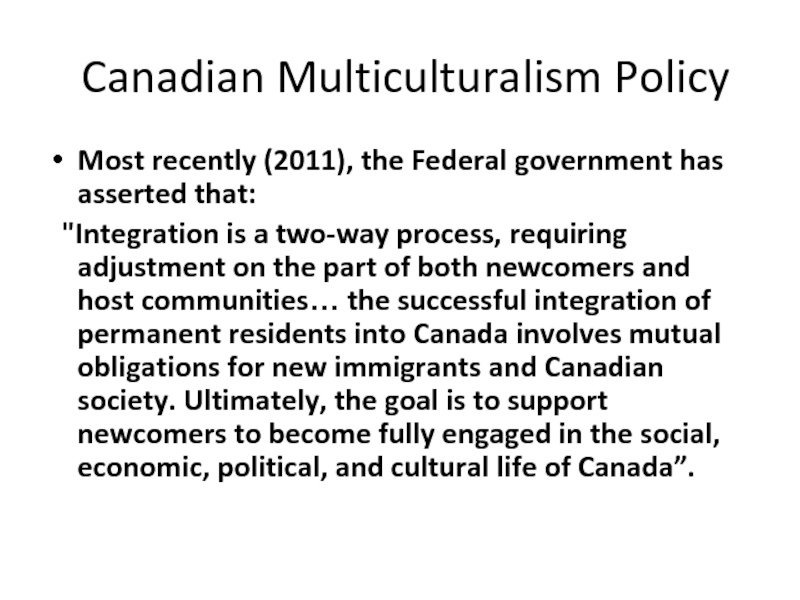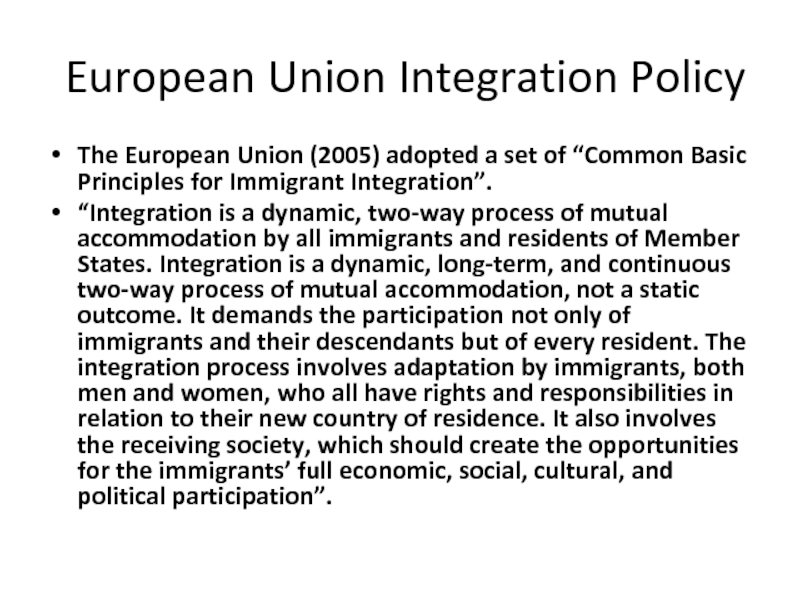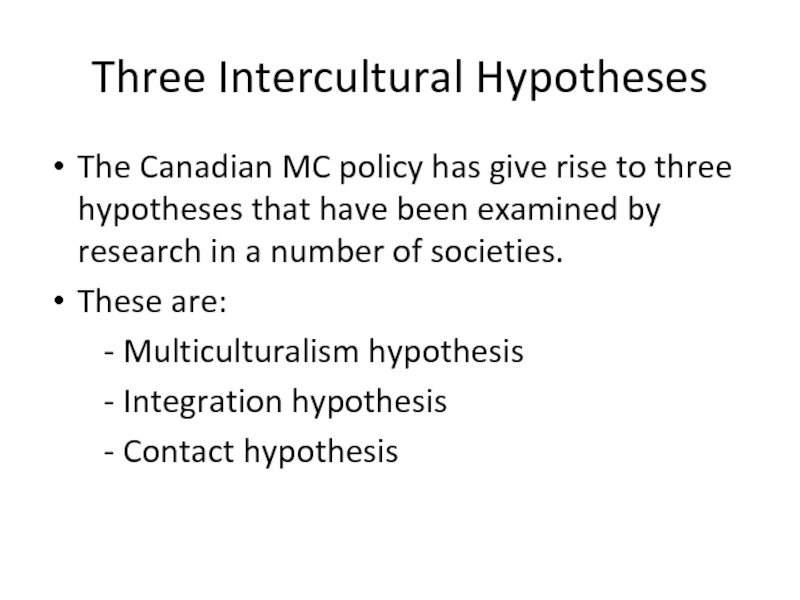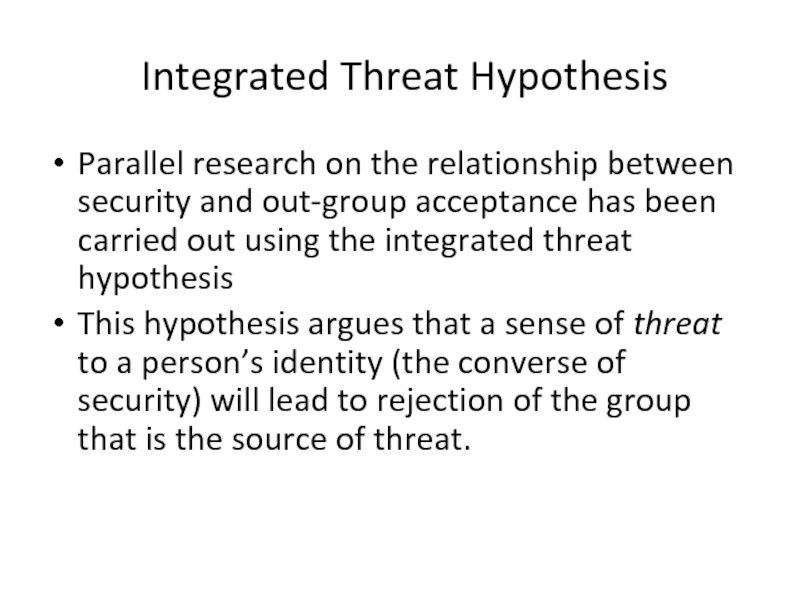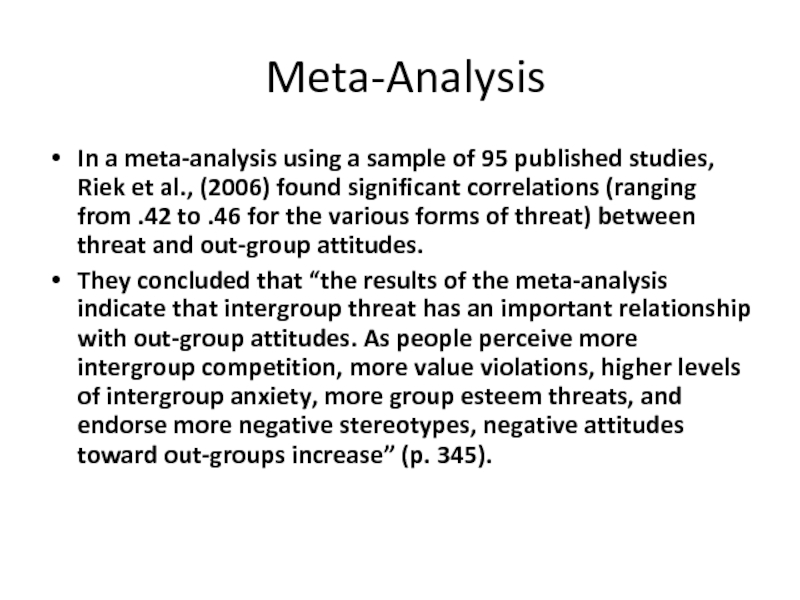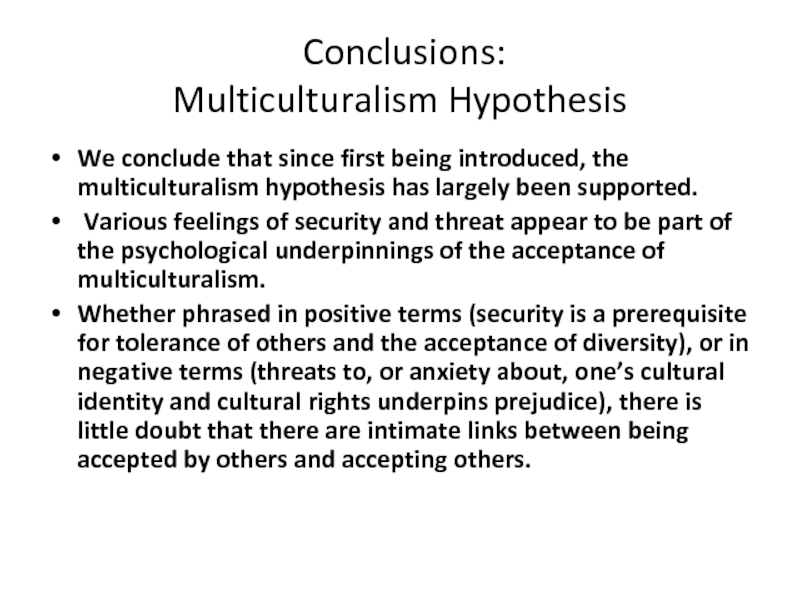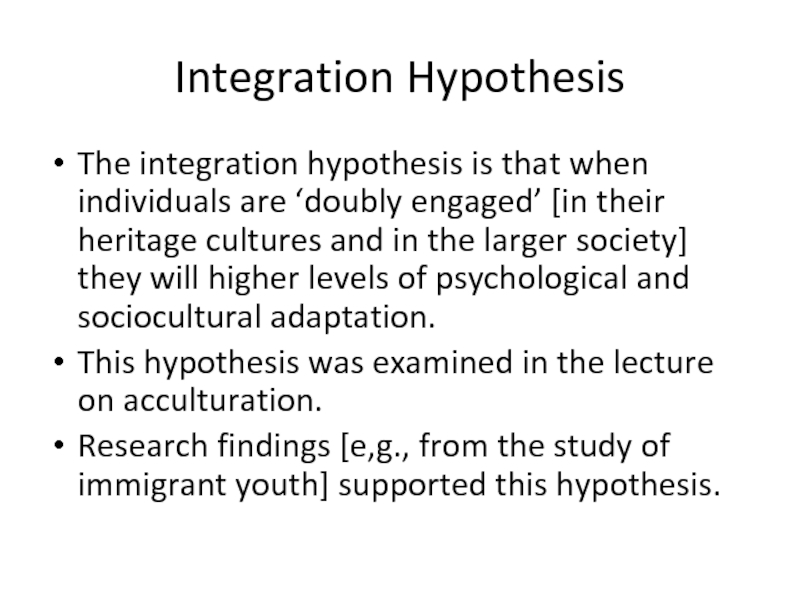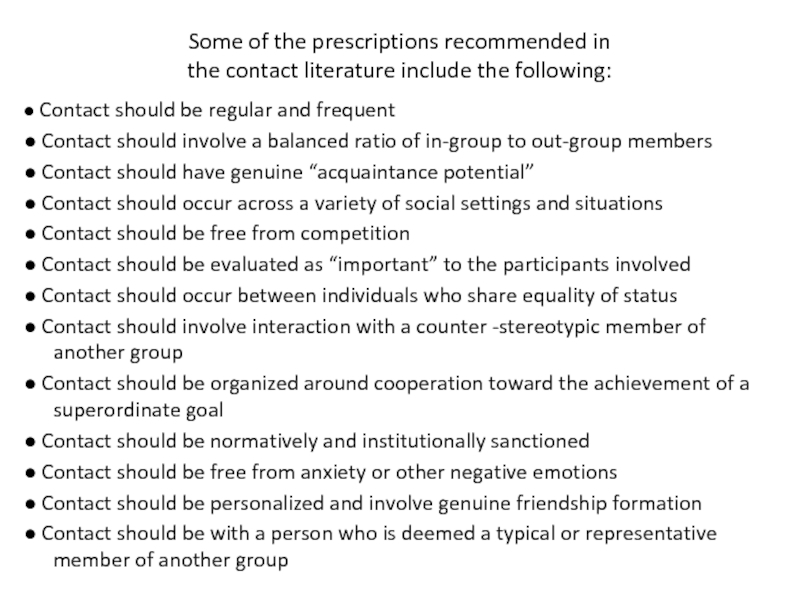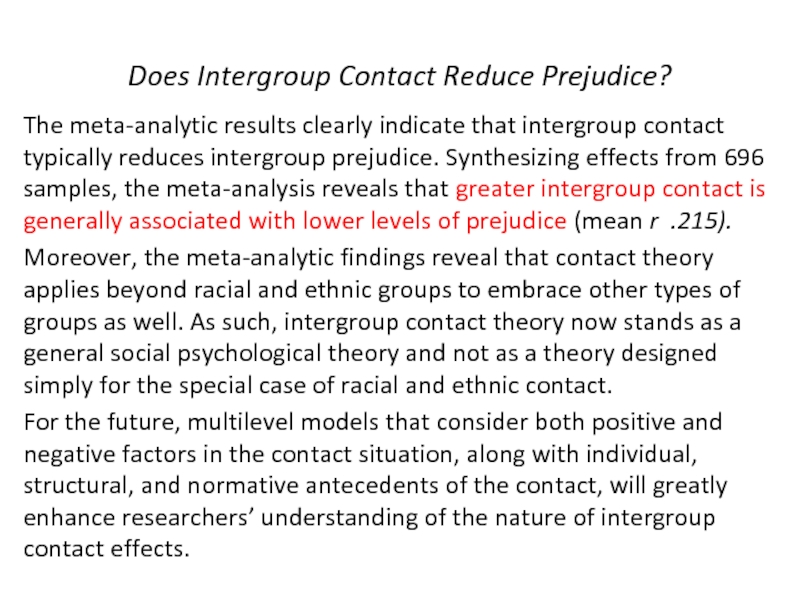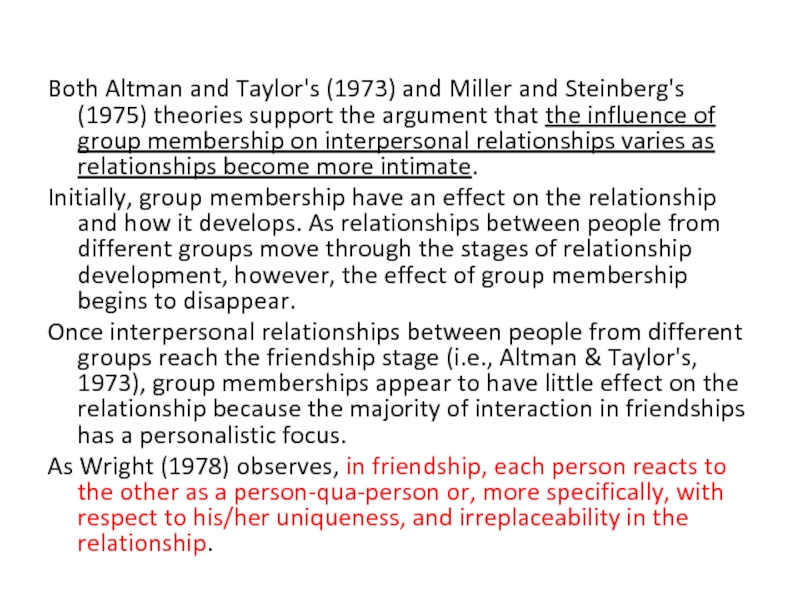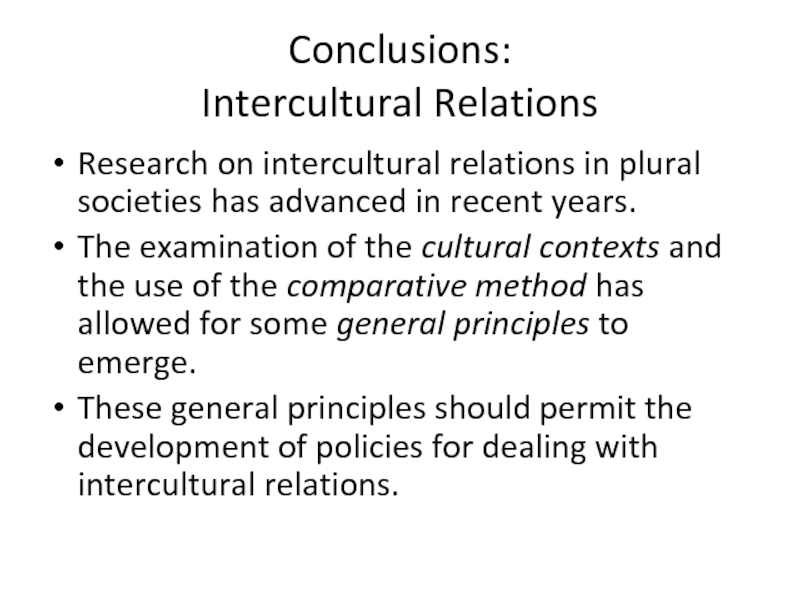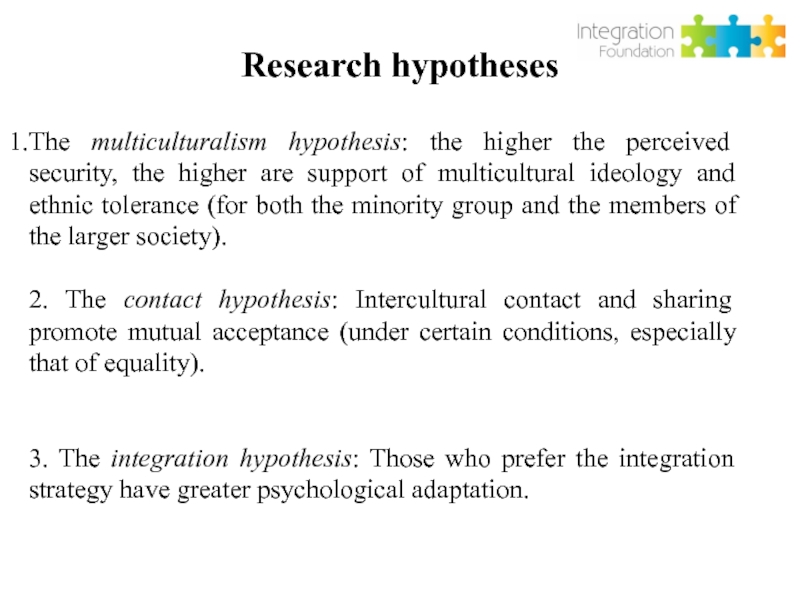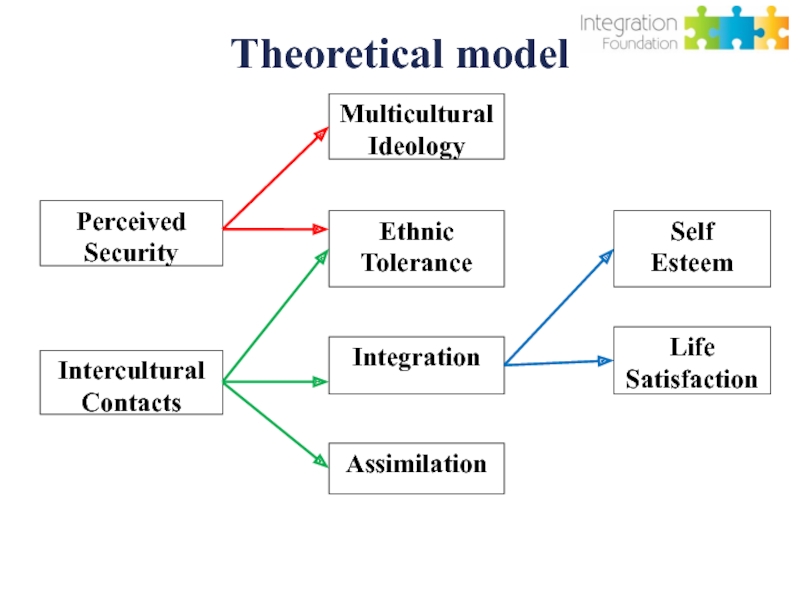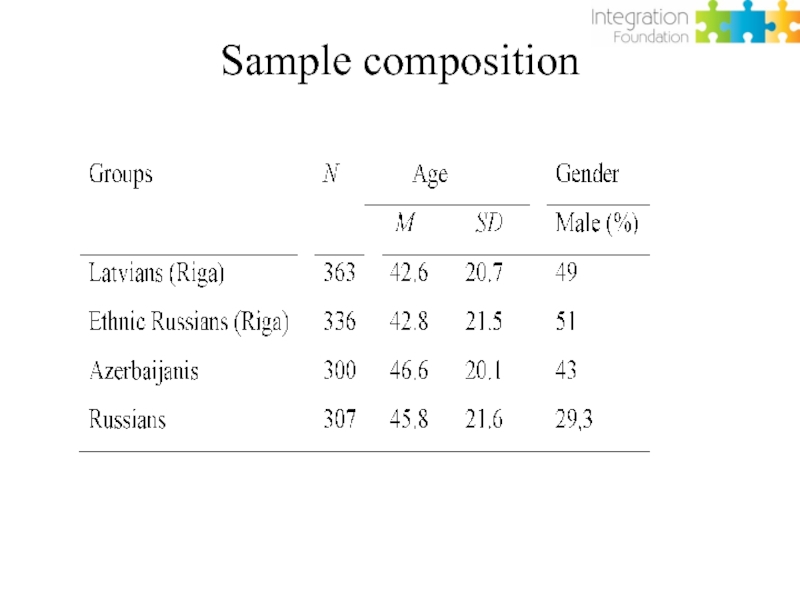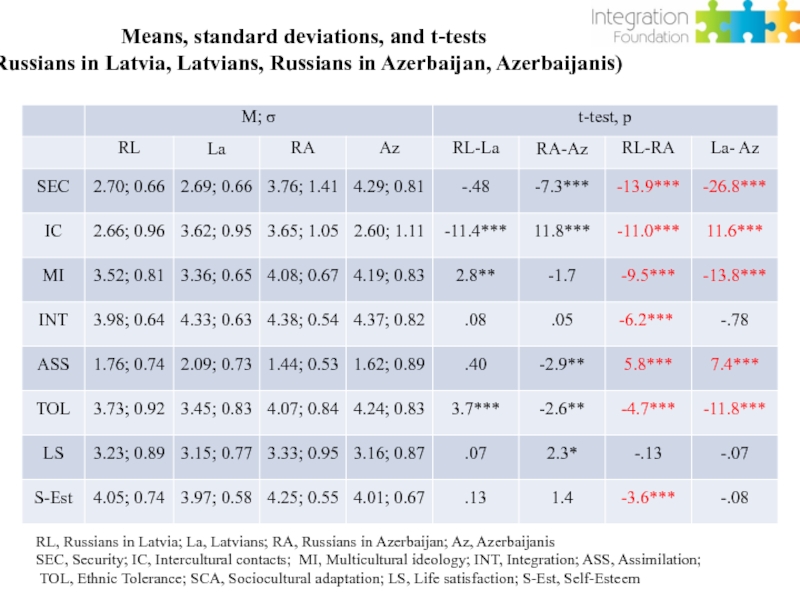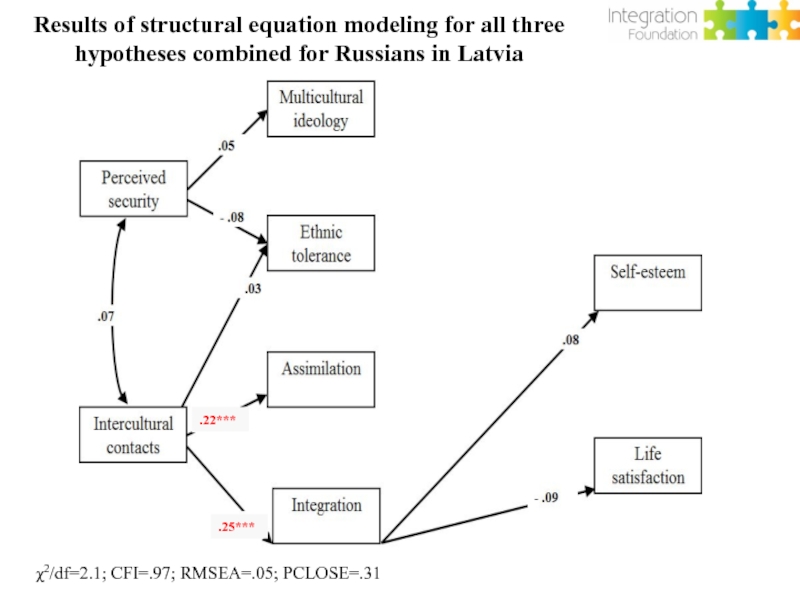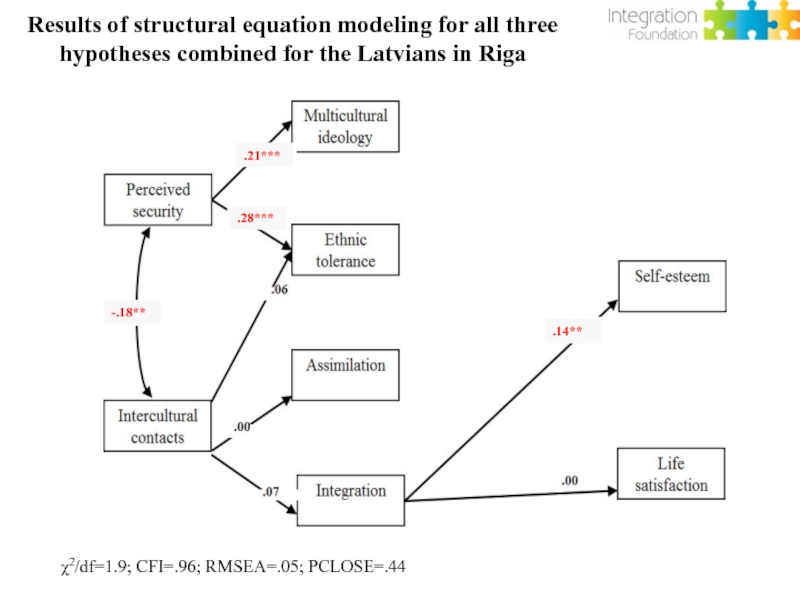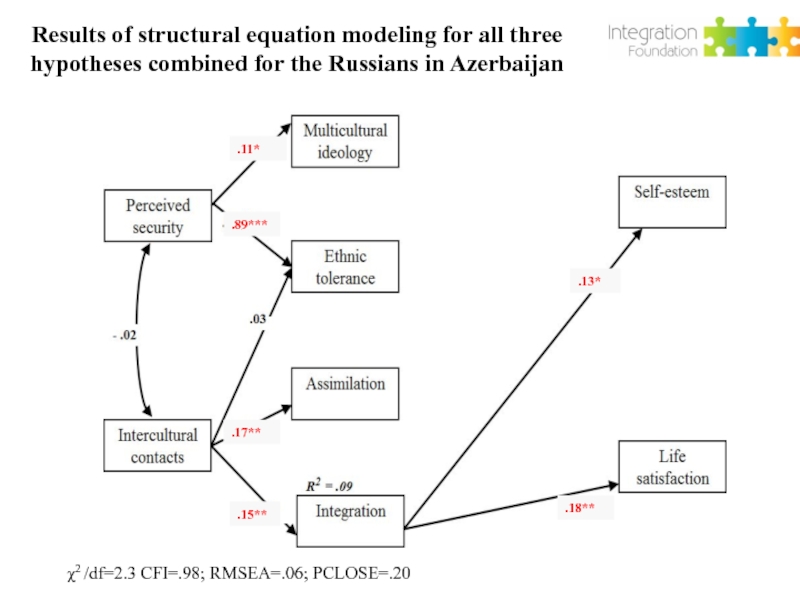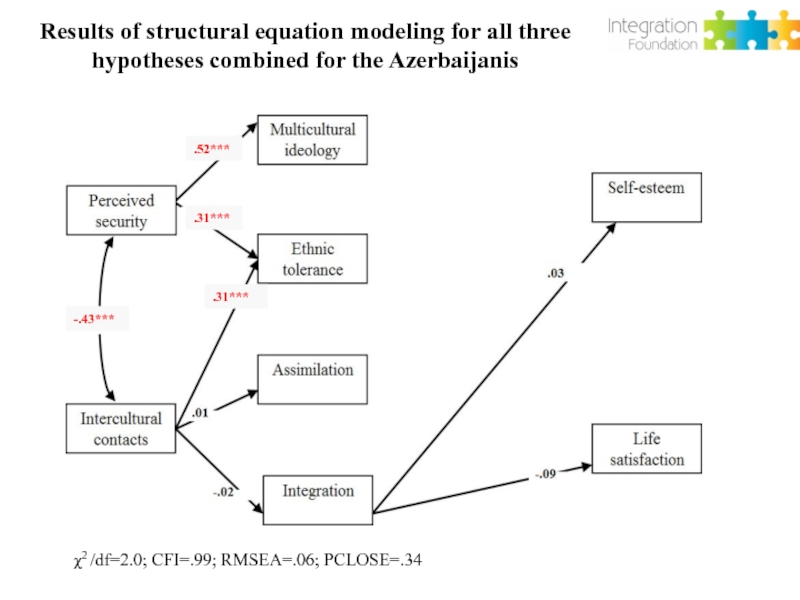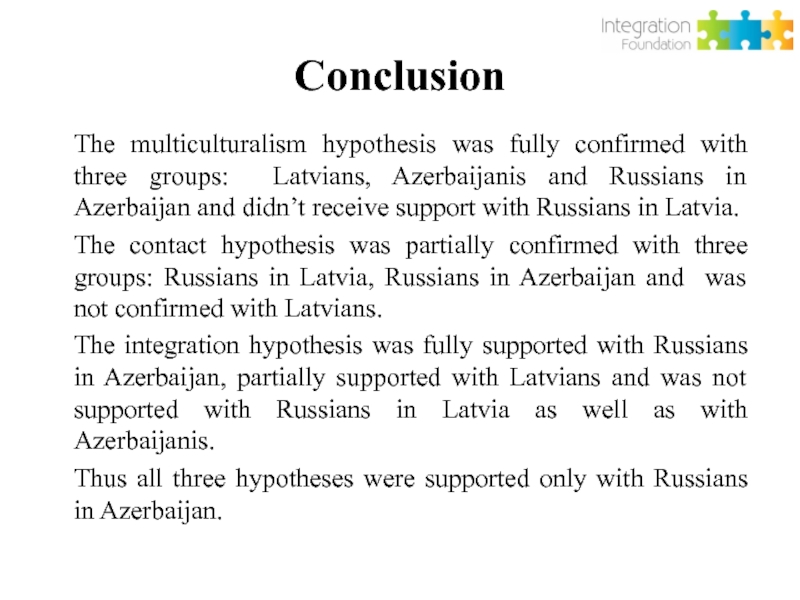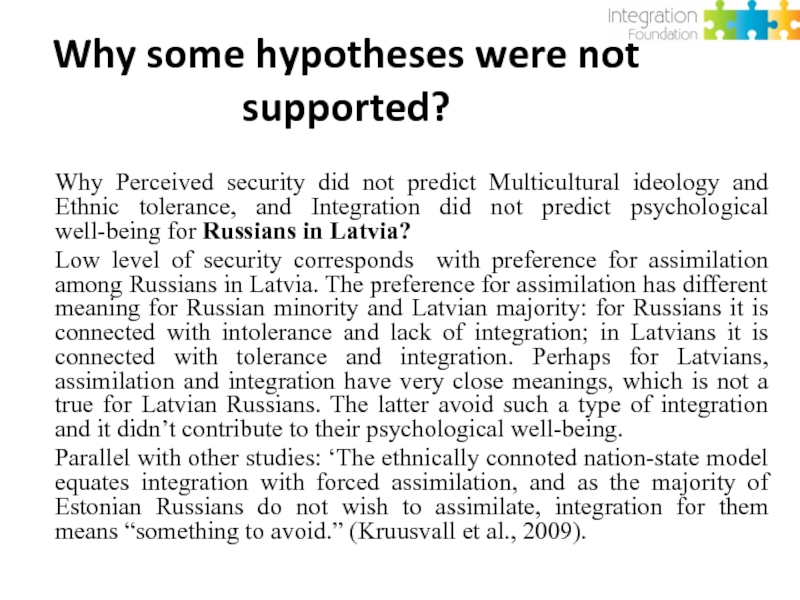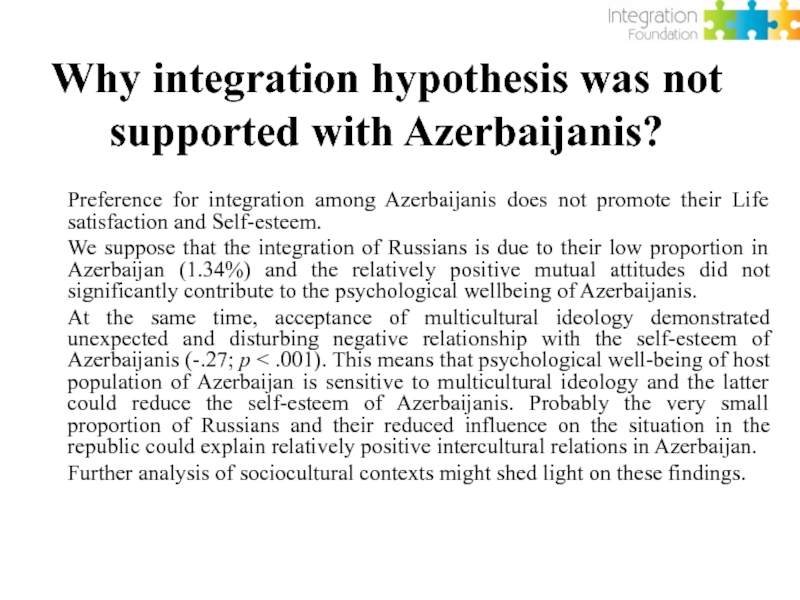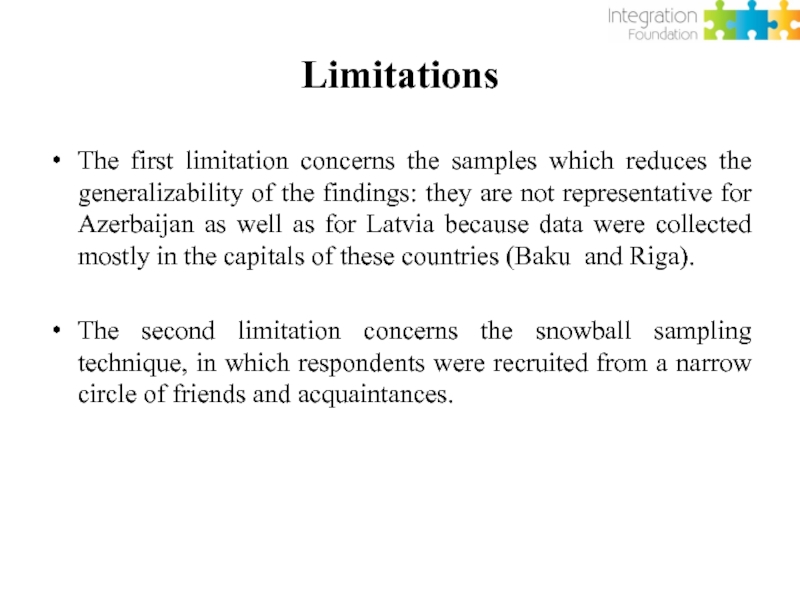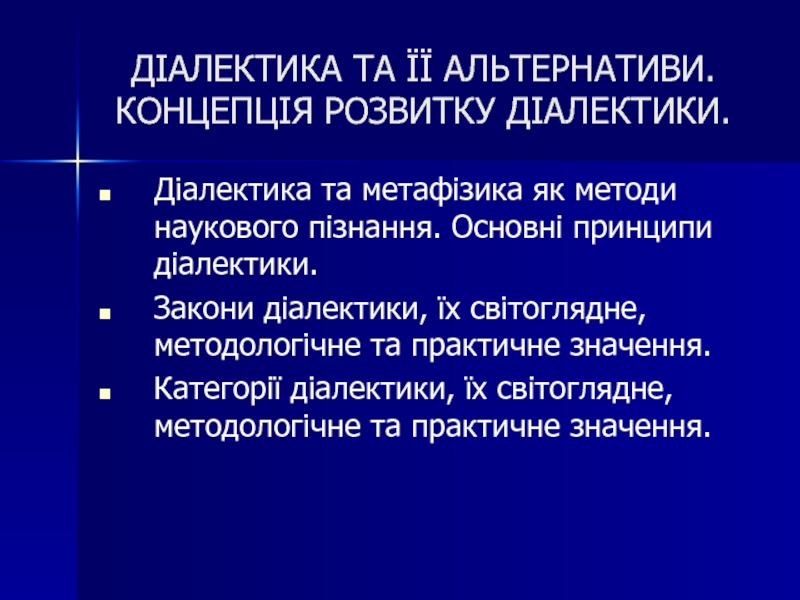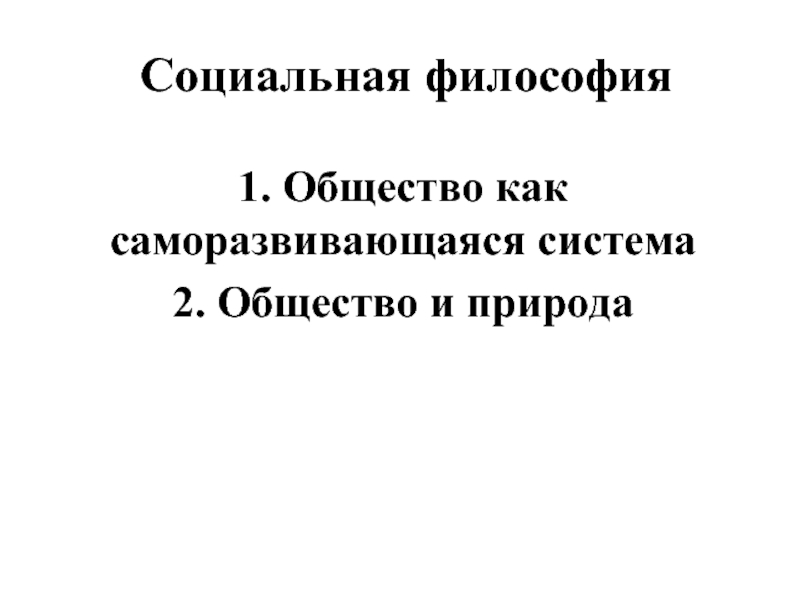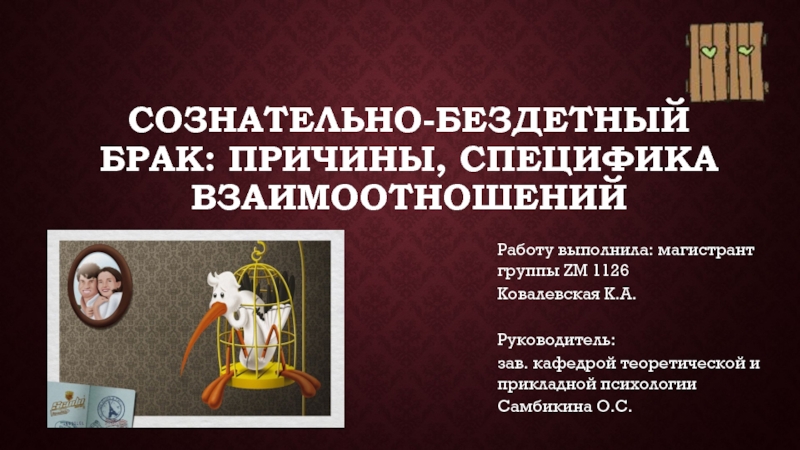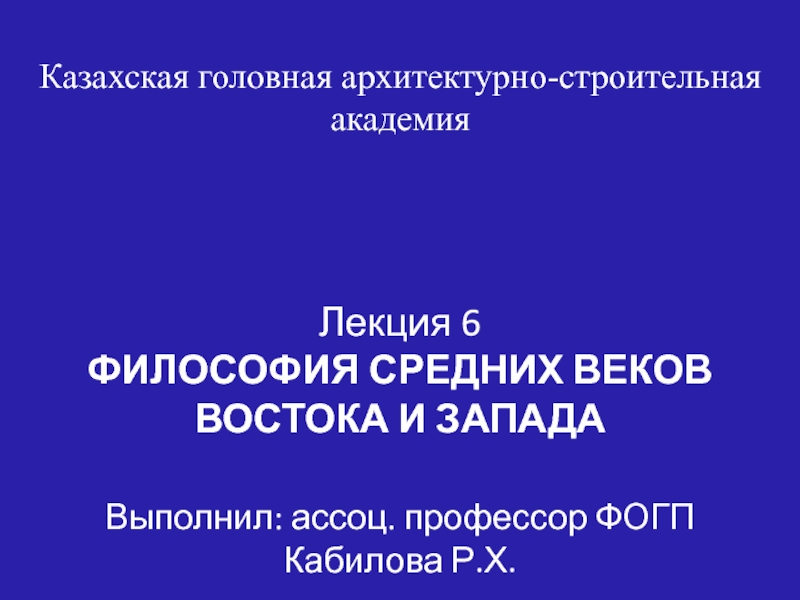- Главная
- Разное
- Дизайн
- Бизнес и предпринимательство
- Аналитика
- Образование
- Развлечения
- Красота и здоровье
- Финансы
- Государство
- Путешествия
- Спорт
- Недвижимость
- Армия
- Графика
- Культурология
- Еда и кулинария
- Лингвистика
- Английский язык
- Астрономия
- Алгебра
- Биология
- География
- Детские презентации
- Информатика
- История
- Литература
- Маркетинг
- Математика
- Медицина
- Менеджмент
- Музыка
- МХК
- Немецкий язык
- ОБЖ
- Обществознание
- Окружающий мир
- Педагогика
- Русский язык
- Технология
- Физика
- Философия
- Химия
- Шаблоны, картинки для презентаций
- Экология
- Экономика
- Юриспруденция
Acculturation and Intercultural Psychology презентация
Содержание
- 1. Acculturation and Intercultural Psychology
- 2. Introduction One result of the intake and
- 3. Introduction In these plural societies, two phenomena
- 4. Plural Societies Plural societies are those that
- 5. Two Implicit Models of Plural Societies
- 6. Plural Societies These groups may be identified
- 7. Types of Groups in Plural Societies
- 8. Some Conclusions Research in intercultural psychology is
- 9. Intercultural Psychology The field of intercultural
- 10. Intercultural psychology
- 11. Intercultural Psychology As for cross-cultural psychology,
- 13. Acculturation Psychology Acculturation is the process
- 14. Acculturation Framework
- 15. Acculturation At the cultural level, there
- 16. Goals of Acculturation Research The goals
- 17. Goals of Acculturation Research These
- 18. Acculturation: Positive and Negative Much
- 19. “Culture shock”: the shock of the new
- 20. Some Symptoms of Acculturative Stress and Their Descriptions
- 21. Acculturation: Positive and Negative As
- 22. Variations in Acculturation It is now
- 23. Acculturation Strategies: The How Question
- 24. 4. Acculturation Strategies: Framework
- 25. Acculturation Strategies On the left are
- 26. Acculturation Strategies: Ethnocultural Groups When
- 27. Acculturation Strategies When there is
- 28. Acculturation Strategies: Larger Society From the
- 29. Acculturation Strategies Findings In most
- 30. Acculturation Empirical Example: Study of Immigrant
- 31. International Comparative Study of Ethnocultural
- 32. How do immigrant youth acculturate ?
- 33. How do immigrant youth acculturate?
- 34. Acculturation Profile Membership Being in
- 35. Acculturation Profiles by Length of Residence
- 36. Perceived Discrimination Respondents were asked to indicate
- 37. Perceived Discrimination by Acculturation Strategy
- 38. How Well do Immigrant
- 39. Immigrant and National Youth Adaptation Using
- 40. Relationships Between Acculturation Strategy and
- 42. Acculturation Policy Implications These consistent relationships
- 43. Policy Implications for National Society
- 44. Policy Implications for Public Institutions For
- 45. Policy Implications for Ethnocultural
- 46. Policy Implications for Ethnocultural Individuals
- 47. Acculturation Conclusions Results of many recent
- 48. Introduction to Intercultural Relations Intercultural contact
- 49. Intercultural Relations Much of the research has
- 50. Intercultural Policies All plural societies are
- 51. Canadian Multiculturalism Policy In 1971, the
- 52. Canadian Multiculturalism Policy
- 53. Canadian Multiculturalism Policy It is essential
- 54. Canadian Multiculturalism Policy Most recently (2011),
- 55. European Union Integration Policy The European
- 56. EU Integration Policy In these EU principles,
- 57. Three Intercultural Hypotheses The Canadian MC policy
- 58. Multiculturalism Hypothesis The multiculturalism hypothesis is that
- 59. Integrated Threat Hypothesis Parallel research on
- 60. Meta-Analysis In a meta-analysis using
- 61. Conclusions: Multiculturalism Hypothesis We conclude that
- 62. Integration Hypothesis The integration hypothesis is that
- 63. Integration Hypothesis A recent meta-analysis by Benet-
- 64. Contact hypothesis The contact hypothesis asserts that
- 65. Meta-Analysis of Contact Hypothesis Pettigrew and
- 66. Meta-Analysis of Contact Hypothesis Most recently, Pettigrew
- 67. Some of the prescriptions recommended
- 69. Does Intergroup Contact Reduce Prejudice? The meta-analytic
- 70. Both Altman and Taylor's (1973) and
- 71. Conclusions: Contact Hypothesis The evidence is now
- 72. Conclusions: Contact Hypothesis One issue still to
- 73. Conclusions: Intercultural Relations Research on intercultural
- 74. Intercultural relations in Latvia and Azerbaijan:
- 75. Research goal To test three hypotheses of
- 76. Research hypotheses The multiculturalism
- 77. Theoretical model Perceived Security Multicultural Ideology
- 78. Comparison of the contexts Latvia Citizenship. Latvians
- 79. Sample composition
- 80. Measures and Procedure The study used some
- 81. Means, standard deviations, and t-tests (Russians
- 82. Results of structural equation modeling for all
- 83. Results of structural equation modeling for all
- 84. Results of structural equation modeling for all
- 85. Results of structural equation modeling for all
- 86. Findings
- 87. Conclusion The multiculturalism hypothesis was fully confirmed
- 88. Why some hypotheses were not supported? Why
- 89. Why contact hypothesis was not supported
- 90. Why integration hypothesis was not supported with
- 91. Limitations The first limitation concerns the samples
Слайд 2Introduction
One result of the intake and settlement of migrants is the
In the contemporary world all societies are now culturally plural, with many ethnocultural groups living in daily interaction.
All industrialised societies will require immigration in order to support their economies and social services.
For example, by 2030, the EU will need 80 million immigrants, the US 35 million, Japan 17 million, and Canada 11 million (Saunders, 2010).
Thus, research into the underpinnings of intercultural relations is an urgent matter in such societies (as well as in the most plural societies of all- Brasil, China, India and most of Africa).
Слайд 3Introduction
In these plural societies, two phenomena (acculturation and intercultural relations) are
As for all cross-cultural psychology, research on intercultural psychology needs to be done comparatively, in the search for some general principles that may be useful in all plural societies
Research on these issues can provide a knowledge basis for the development and implementation of policies and programmes in plural societies in order to improve intercultural relations.
Слайд 4Plural Societies
Plural societies are those that have many cultural, linguistic and
There are two implicit modes for thinking about how diverse groups may live together in plural societies:
- melting pot ( one common identity)
- multicultural (many identities)
Слайд 6Plural Societies
These groups may be identified by examining three dimensions of
(i) mobility
(ii) voluntariness
(iii) permanence
Слайд 8Some Conclusions
Research in intercultural psychology is essential for the improvement of
Plural societies provide the context for most research in intercultural psychology.
Acculturation and Intercultural Relations are the two core areas of research and application.
As for all work in cross-cultural psychology:
- the cultural context needs to be examined, and
- the research be done comparatively.
Слайд 9 Intercultural Psychology
The field of intercultural psychology has two
- Acculturation
- Intercultural relations
In the following figure the core concepts of each branch are shown.
Слайд 11 Intercultural Psychology
As for cross-cultural psychology, it is essential to first
Armed with conceptual and empirical knowledge, it should be possible to achieve harmonious and effective intercultural relations, and to avoid conflictual and stressful relations (at bottom).
Слайд 13 Acculturation Psychology
Acculturation is the process of cultural
and psychological
It takes place in both groups and all individuals in contact.
Although one group is usually dominant over the others, successful outcomes require mutual accommodation among all groups and individuals living together in the diverse society.
Слайд 15 Acculturation
At the cultural level, there are three phenomena that need
- features of the groups prior to their contact,
- the nature of their intercultural relationships,
- the cultural changes following their contact.
At the psychological level, there are also three phenomena:
- behavioural changes (in daily repertoire, identity),
- stress reactions (acculturative stress),
- adaptations (psychological and sociocultural).
Слайд 16 Goals of Acculturation Research
The goals of acculturation research are:
-
- to examine how individuals and groups acculturate,
- to examine how well individuals and groups adapt
- to search for relationships between how and how well, in order to discover if there is a best practice,
- to apply these findings to the betterment and
wellbeing of immigrant and ethnocultural
individuals and groups.
Слайд 17 Goals of Acculturation Research
These same goals apply equally to all
Without an understanding of how they are impacted by immigration and acculturation, there can be no improvement in the wellbeing for immigrant and ethnocultural groups when their social, economic and political environments remain unchanged, and often negative because of prejudice and discrimination.
Слайд 18 Acculturation:
Positive and Negative
Much early research on acculturation provided ‘evidence’
This ‘evidence’ was often published by those who provided services to persons and groups who were in difficulty following immigration (psychiatrists, social workers and other clinicians)
These workers rarely made observations on persons who made satisfactory acculturative transitions.
Слайд 19“Culture shock”: the shock of the new
“Culture shock” or acculturative
Слайд 21 Acculturation:
Positive and Negative
As more community surveys were carried out,
In some studies, acculturating individuals achieved equal or even better levels of wellbeing than those already settled in the larger society.
As a result, a more balanced picture of the process and outcomes of acculturation has emerged.
Слайд 22 Variations in Acculturation
It is now well established that acculturation takes
These variations appear in regard to how people acculturate and how well they adapt.
The most important question is whether there are relationships between how people acculturate and how well they adapt.
As noted above, if there are such relationships, then there may be a best practice for societies, groups and individuals to follow during the process of acculturation
Слайд 23 Acculturation Strategies:
The How Question
Groups and individuals in acculturating groups
These views concern two underlying issues:
1.Maintenance of heritage cultural and identity in order to sustain cultural communities,
2. Participation with other groups in the life of the national society.
Their intersection produces four acculturation strategies used by groups in contact
These strategies represent the how issue mentioned earlier.
Слайд 25 Acculturation Strategies
On the left are the terms used for the
On the right are the terms used for the strategies adopted by individual members of the larger society, and for societal policies used to manage acculturation.
The terms define various locations in the acculturation space.
Individual and groups explore these various options during the process of acculturation, but eventually settle on one place as their preferred way to acculturate.
Слайд 26 Acculturation Strategies: Ethnocultural Groups
When these two issues are crossed,
For non-dominant ethnocultural groups, orientations to these issues intersect to define the four acculturation strategies of assimilation, separation, integration and marginalization.
When individuals do not wish to maintain their cultural identity and seek daily interaction with other cultures, the Assimilation strategy is defined.
In contrast, when individuals place a value on holding on to their original culture, and at the same time wish to avoid interaction with others, then the Separation alternative is defined.
Слайд 27 Acculturation Strategies
When there is little possibility or interest in
Finally, when there is an interest in both maintaining one’s original culture, while in daily interactions with other groups, the Integration strategy is defined. In this case, there is some degree of cultural integrity maintained, while at the same time seeking, as a member of an ethnocultural group, there is a desire to participate as an integral part of the larger society.
Note that integration has a very specific meaning within this framework: it is clearly different from assimilation (because there is substantial cultural maintenance with integration), and it is not a generic term referring to just any kind of long term presence, or involvement, of an immigrant group in a society of settlement.
Слайд 28 Acculturation Strategies:
Larger Society
From the point of view of the larger
Assimilation when sought by the dominant group is termed the Melting Pot.
When Separation is forced by the dominant group it is called Segregation.
Marginalisation, when imposed by the dominant group is called Exclusion.
Finally, Integration, when diversity is a widely accepted and valued feature of the society as a whole, including by all the various ethnocultural groups, it is called Multiculturalism.
Слайд 29 Acculturation Strategies Findings
In most research, integration is found to
In some research with indigenous peoples and sojourners, separation is preferred.
In a few studies with refugees, assimilation is preferred.
In no studies is marginalisation preferred.
Слайд 30Acculturation Empirical Example:
Study of Immigrant Youth
Book: Immigrant youth in cultural
Article in Applied Psychology (2006).
Both by John Berry, Jean Phinney, David Sam and Paul Vedder.
Слайд 31 International Comparative Study of Ethnocultural Youth
13 SOCIETIES
(5 Settler,8 Recent)
32 IMMIGRANT GROUPS
Immigrant youth N =5366
(aged 13 -18; 65.3% 2nd generation)
Immigrant parents N =2302
National youth N = 2631
National parents N = 863
Слайд 32 How do immigrant youth acculturate ?
Used 13 intercultural variables:
Acculturation attitudes
Cultural identities (ethnic, national)
Language use (ethnic, national)
Social relationships (ethnic, national)
Family relationship values (obligations,
rights)
Слайд 33 How do immigrant youth acculturate?
Cluster analysis of these 13
- Integration: 36.4% (oriented to both cults.)
- Separation: 22.5 % (oriented to heritage)
- Assimilation:18.7 % (oriented to national)
- Marginalisation: 22.4%(oriented to neither)
Слайд 34
Acculturation Profile Membership
Being in a cluster or profile is related
1. Length of residence in the new society
2. Discrimination against self and group
Слайд 36Perceived Discrimination
Respondents were asked to indicate (in response to 5 questions)
Sample items were: “I don’t feel accepted by (national) group”. And “ I have been teased or insulted because of my ethnic background”.
Discrimination was the single most important contibutor to not achieving integration, and to being marginalised.
Слайд 38
How Well do Immigrant
Youth Adapt?
Two forms of adaptation were
1. Psychological: Lack of Psychological Problems (anxiety, depression, psychosomatic symptoms), high Self-esteem, Life satisfaction.
2. Sociocultural: good School Adjustment, lack of Behaviour Problems (eg., truancy, petty theft).
Слайд 39 Immigrant and National
Youth Adaptation
Using the national youth as the comparison
Immigrant youth reported slightly fewer psychological problems, better school adjustment and fewer behavior problems, although no significant differences were found between immigrants and their national peers in the areas of life satisfaction and self-esteem.
Слайд 40
Relationships Between Acculturation Strategy and Adaptation
Are there relationships between how
Psychological Adaptation: Integration highest; followed by Separation, then Assimilation; Marginalisation lowest.
Sociocultural Adaptation: Integration highest; followed by Assimilation, then Separation; Marginalisation lowest.
Слайд 42Acculturation Policy Implications
These consistent relationships may permit the development of
the national society,
public institutions,
ethnocultural groups,
- individuals.
Слайд 43 Policy Implications for National Society
In the national society, public
Multiculturalism, supporting the integration of all individuals and groups, will serve the general good more than any of the other ways of acculturating.
At all cost, the descent into Marginalisation should be avoided.
Слайд 44 Policy Implications for Public Institutions
For public institutions, such as those
Changing these institutions requires :
- the elimination of ideologies and practices that exclude or diminish acculturating peoples;
- the insertion of ideologies and practices that include the cultural and psychological qualities that acculturating peoples value.
Слайд 45 Policy Implications for
Ethnocultural Communities
For all ethnocultural communities,
Participation without maintenance promotes Assimilation, and threatens the group’s security.
Maintenance without participation promotes Separation, and threatens the dominant group’s security.
Engaging in both promotes Integration, and avoids Marginalisation.
Слайд 46 Policy Implications for
Ethnocultural Individuals
For individuals, the general
Слайд 47Acculturation Conclusions
Results of many recent studies of acculturation and adaptation
Variations in outcomes appear to be related to a number of factors, some of which can be managed by public and private action.
The use of these findings to develop public policies and programmes should be a major focus of current efforts to improve the wellbeing of all acculturating groups and individuals.
Слайд 48Introduction to
Intercultural Relations
Intercultural contact take place in all plural societies.
When
More generally, prejudice and discrimination may increase or decrease.
Research on the outcomes of contact is essential to improving intercultural relations.
Слайд 49Intercultural Relations
Much of the research has been carried out in “settler
A key research question is whether findings from these societies apply to nation states that have long-established national and regional cultures, such as those in Europe and Asia.
Comparative research on psychological aspects of culture contact following migration and settlement is essential in order to answer this question.
Слайд 50 Intercultural Policies
All plural societies are now attempting to deal with
Some declare that “multiculturalism has failed”, having tried a policy that is not multiculturalism at all (in the terms used here), but is essentially one of separation.
As an alternative, they usually propose the term ‘integration’, usually meaning a form of ‘assimilation’.
Others propose that ‘integration’, through a policy of multiculturalism, is the only possible solution.
Following is a summary of the first such policy (in Canada, 1971), and of the EU (2005) policy.
Слайд 51
Canadian Multiculturalism Policy
In 1971, the Canadian Federal government announced a policy
This goal of improved intercultural relations was to be achieved by:
- supporting ethnocultural communities in their wish to maintain their heritage cultures, and
- by promoting intercultural contact and participation in the larger society.
Слайд 53 Canadian Multiculturalism Policy
It is essential to note that the concept
the maintenance and development of heritage cultures and identities (the cultural component) and,
the full and equitable participation of all ethnocultural groups in the life of the larger society (the social component).
Together, and in balance with each other, it should be possible to achieve a functioning multicultural society.
Note that these two components are identical to the acculturation strategies framework presented in the last lecture
3. A third component is that of learning either or both ‘official languages’ (English or French) in order to permit mutual understanding and participation in the larger society.
Слайд 54 Canadian Multiculturalism Policy
Most recently (2011), the Federal government has asserted
"Integration is a two-way process, requiring adjustment on the part of both newcomers and host communities… the successful integration of permanent residents into Canada involves mutual obligations for new immigrants and Canadian society. Ultimately, the goal is to support newcomers to become fully engaged in the social, economic, political, and cultural life of Canada”.
Слайд 55 European Union Integration Policy
The European Union (2005) adopted a set
“Integration is a dynamic, two-way process of mutual accommodation by all immigrants and residents of Member States. Integration is a dynamic, long-term, and continuous two-way process of mutual accommodation, not a static outcome. It demands the participation not only of immigrants and their descendants but of every resident. The integration process involves adaptation by immigrants, both men and women, who all have rights and responsibilities in relation to their new country of residence. It also involves the receiving society, which should create the opportunities for the immigrants’ full economic, social, cultural, and political participation”.
Слайд 56EU Integration Policy
In these EU principles, the cornerstones of multiculturalism policy
the right of all peoples to maintain their cultures;
the right to participate fully in the life of the larger society; and
the obligation for all groups (both the dominant and non-dominant) to engage in a process of mutual change.
Note that there is no place for the option of permitting cultural maintenance in the family or cultural community (private maintenance), while rejecting such expressions in the public space.
Слайд 57Three Intercultural Hypotheses
The Canadian MC policy has give rise to three
These are:
- Multiculturalism hypothesis
- Integration hypothesis
- Contact hypothesis
Слайд 58Multiculturalism Hypothesis
The multiculturalism hypothesis is that when individuals and societies are
In contrast, when these identities are threatened,
mutual hostility will result.
This hypothesis derives from the policy statement that positive relations “…must be founded on confidence on one’s own individual identity; out of this can grow respect for that of others, and a willingness to share ideas, attitudes and assumptions…”.
Слайд 59 Integrated Threat Hypothesis
Parallel research on the relationship between security and
This hypothesis argues that a sense of threat to a person’s identity (the converse of security) will lead to rejection of the group that is the source of threat.
Слайд 60 Meta-Analysis
In a meta-analysis using a sample of 95 published
They concluded that “the results of the meta-analysis indicate that intergroup threat has an important relationship with out-group attitudes. As people perceive more intergroup competition, more value violations, higher levels of intergroup anxiety, more group esteem threats, and endorse more negative stereotypes, negative attitudes toward out-groups increase” (p. 345).
Слайд 61 Conclusions:
Multiculturalism Hypothesis
We conclude that since first being introduced, the multiculturalism
Various feelings of security and threat appear to be part of the psychological underpinnings of the acceptance of multiculturalism.
Whether phrased in positive terms (security is a prerequisite for tolerance of others and the acceptance of diversity), or in negative terms (threats to, or anxiety about, one’s cultural identity and cultural rights underpins prejudice), there is little doubt that there are intimate links between being accepted by others and accepting others.
Слайд 62Integration Hypothesis
The integration hypothesis is that when individuals are ‘doubly engaged’
This hypothesis was examined in the lecture on acculturation.
Research findings [e,g., from the study of immigrant youth] supported this hypothesis.
Слайд 63Integration Hypothesis
A recent meta-analysis by Benet- Martinez has shown that this
In over 80 studies (with over 8000 participants) integration (‘biculturalism’ in her terms) was positively associated with positive adaptation (‘adjustment’ in her terms).
From these studies, we may conclude that the integration hypothesis is largely supported.
Слайд 64Contact hypothesis
The contact hypothesis asserts that “Prejudice...may be reduced by equal
However, Allport proposed that the hypothesis is more likely to be supported when certain conditions are present in the intercultural encounter.
The effect of contact is predicted to be stronger when: - there is contact between groups of roughly equal social and economic status;
- when the contact is voluntary, sought by both groups, rather than imposed; and
- when supported by society, through norms and laws promoting contact and prohibiting discrimination.
Слайд 65Meta-Analysis of Contact Hypothesis
Pettigrew and Tropp (2001) conducted a meta-analyses of
Their findings provide general support for the contact hypothesis: intergroup contact does generally relate negatively to prejudice in both dominant and non-dominant samples: “Overall, results from the meta-analysis reveal that greater levels of intergroup contact are typically associated with lower level of prejudice...” (Pettigrew & Tropp, 2001, p. 267).
This effect was stronger where there were structured programs that incorporated the conditions outlined by Allport than when these conditions were not present.
Слайд 66Meta-Analysis of Contact Hypothesis
Most recently, Pettigrew and Tropp (2011) continued their
They confirmed the findings of their previous research: contact (under most conditions) leads to more positive attitudes, and reduced prejudice.
Слайд 67
Some of the prescriptions recommended in
the contact literature include the following:
●
● Contact should involve a balanced ratio of in-group to out-group members
● Contact should have genuine “acquaintance potential”
● Contact should occur across a variety of social settings and situations
● Contact should be free from competition
● Contact should be evaluated as “important” to the participants involved
● Contact should occur between individuals who share equality of status
● Contact should involve interaction with a counter -stereotypic member of another group
● Contact should be organized around cooperation toward the achievement of a superordinate goal
● Contact should be normatively and institutionally sanctioned
● Contact should be free from anxiety or other negative emotions
● Contact should be personalized and involve genuine friendship formation
● Contact should be with a person who is deemed a typical or representative member of another group
Слайд 69Does Intergroup Contact Reduce Prejudice?
The meta-analytic results clearly indicate that intergroup
Moreover, the meta-analytic findings reveal that contact theory applies beyond racial and ethnic groups to embrace other types of groups as well. As such, intergroup contact theory now stands as a general social psychological theory and not as a theory designed simply for the special case of racial and ethnic contact.
For the future, multilevel models that consider both positive and negative factors in the contact situation, along with individual, structural, and normative antecedents of the contact, will greatly enhance researchers’ understanding of the nature of intergroup contact effects.
Слайд 70
Both Altman and Taylor's (1973) and Miller and Steinberg's (1975) theories
Initially, group membership have an effect on the relationship and how it develops. As relationships between people from different groups move through the stages of relationship development, however, the effect of group membership begins to disappear.
Once interpersonal relationships between people from different groups reach the friendship stage (i.e., Altman & Taylor's, 1973), group memberships appear to have little effect on the relationship because the majority of interaction in friendships has a personalistic focus.
As Wright (1978) observes, in friendship, each person reacts to the other as a person-qua-person or, more specifically, with respect to his/her uniqueness, and irreplaceability in the relationship.
Слайд 71Conclusions: Contact Hypothesis
The evidence is now widespread across cultures that greater
This generalisation has to be qualified by two cautions.
First, the appropriate conditions need to be present in order for contact to lead to positive intercultural attitudes.
And second, there exists many examples of the opposite effect, where increased contact is associated with greater conflict. The conditions (cultural, political, economic) under which these opposite outcomes arise are in urgent need of examination.
Слайд 72Conclusions: Contact Hypothesis
One issue still to be decided is whether the
It appears settled that the positive effects are usually present when individuals meet.
However, less clear is whether they are also present at the group level: does contact between groups (communities, states) breed conflict and hostility, or mutual acceptance?
Слайд 73Conclusions:
Intercultural Relations
Research on intercultural relations in plural societies has advanced
The examination of the cultural contexts and the use of the comparative method has allowed for some general principles to emerge.
These general principles should permit the development of policies for dealing with intercultural relations.
Слайд 74Intercultural relations
in Latvia and Azerbaijan:
comparative analysis
Nadezhda Lebedeva, Victoria Galyapina
National
the Role of Culture, Media and Civil Society“ 16 – 17 November 2017 in Tallinn, Estonia
Слайд 75Research goal
To test three hypotheses of intercultural relations (multiculturalism, contact, integration)
The research was supported by the Russian Science Foundation
(project "Empirical test of feasibility of multiculturalism policy
in Russia in the context of international experience", №15-18-00029)
Слайд 76
Research hypotheses
The multiculturalism hypothesis: the higher the perceived security, the higher
2. The contact hypothesis: Intercultural contact and sharing promote mutual acceptance (under certain conditions, especially that of equality).
3. The integration hypothesis: Those who prefer the integration strategy have greater psychological adaptation.
Слайд 77Theoretical model
Perceived
Security
Multicultural
Ideology
Ethnic Tolerance
Integration
Assimilation
Intercultural Contacts
Self
Esteem
Life Satisfaction
Слайд 78Comparison of the contexts
Latvia
Citizenship. Latvians - 61.1%, Russians -26,2% (Statistical Yearbook
Language. In 2004 60% of teaching hours in secondary schools should be taught in the Latvian language. Final exams of the core disciplines are accepted only in the Latvian language. Over the past 10 years, 96 of Russian schools are closed in Latvia. (Solopenko 2013). Since 1999 in Latvia, according to the Education Act, in public universities and colleges the language of instruction is Latvian only (Skrinnik, 2009).
Intercultural relations. Education reform in Latvia has become a catalyst for dissent among the Russian-speaking population. (Sytin¸2012 Skrinnik, 2009). Total ethnic situation in Latvia is a conflict-prone (Rodin, 2013).
Azerbaijan
Citizenship. Russians in Azerbaijan amount to 1.34% of the total population (Perepisi, 2013).Russian, who stayed in Azerbaijan after the collapse of the USSR, received citizenship in this country automatically. (Vykhovanets, 2005).
Language. Russian language is still widely used in everyday communication in Azerbaijan, 47% of ethnic Azerbaijanis speak Russian (Musabekov, 2011). Not one Russian school has not been closed, more than 109 thousand schoolchildren (11%) and 20 thousand of university students are studying in Russian. In 2000 year Baku Slavic University (BSU) was founded (Gavrilov, Kozievskaya, Yatsenko, 2008), the language of instruction is Russian.
Intercultural relations The results of many studies haven’t shown significant problems in the inter-ethnic relations in Azerbaijan. (Guliev, 2012; Azerbaijan in 2006-2010, 2011; Faradov, 2011)
Слайд 80Measures and Procedure
The study used some scales and items from the
The scales used are: Perceived security scale, Multicultural Ideology, Ethnic Tolerance, Intercultural strategies of the nondominant population, Intercultural expectations of the dominant population, , Sociocultural adaptation, The Satisfaction With Life Scale (SWLS), The Rosenberg Self-esteem Scale (RSES), Intercultural (Ethnic) Contacts.
Data processing: structural equation modeling (SEM) and path analysis with AMOS version 19 (Arbuckle, 2010).
Procedure
In Riga the snowball technique was used; for Russians, the survey was conducted in Russian, for Latvians it was conducted in Latvian.
The research in Azerbaijan was conducted by the Center for Research of Development and International Cooperation "SIGMA". They used convenience sampling in the survey process. For Russians and Azerbaijanis, the survey was conducted in Russian.
Слайд 81Means, standard deviations, and t-tests (Russians in Latvia, Latvians, Russians in
RL, Russians in Latvia; La, Latvians; RA, Russians in Azerbaijan; Az, Azerbaijanis
SEC, Security; IC, Intercultural contacts; MI, Multicultural ideology; INT, Integration; ASS, Assimilation;
TOL, Ethnic Tolerance; SCA, Sociocultural adaptation; LS, Life satisfaction; S-Est, Self-Esteem
Слайд 82Results of structural equation modeling for all three hypotheses combined for
χ2/df=2.1; CFI=.97; RMSEA=.05; PCLOSE=.31
.22***
.25***
Слайд 83Results of structural equation modeling for all three hypotheses combined for
χ2/df=1.9; CFI=.96; RMSEA=.05; PCLOSE=.44
.21***
.28***
-.18**
.14**
Слайд 84Results of structural equation modeling for all three hypotheses combined for
χ2 /df=2.3 CFI=.98; RMSEA=.06; PCLOSE=.20
.11*
.89***
.17**
.15**
.13*
.18**
Слайд 85Results of structural equation modeling for all three hypotheses combined for
χ2 /df=2.0; CFI=.99; RMSEA=.06; PCLOSE=.34
.52***
.31***
.31***
-.43***
Слайд 87Conclusion
The multiculturalism hypothesis was fully confirmed with three groups: Latvians, Azerbaijanis
The contact hypothesis was partially confirmed with three groups: Russians in Latvia, Russians in Azerbaijan and was not confirmed with Latvians.
The integration hypothesis was fully supported with Russians in Azerbaijan, partially supported with Latvians and was not supported with Russians in Latvia as well as with Azerbaijanis.
Thus all three hypotheses were supported only with Russians in Azerbaijan.
Слайд 88Why some hypotheses were not supported?
Why Perceived security did not predict
Low level of security corresponds with preference for assimilation among Russians in Latvia. The preference for assimilation has different meaning for Russian minority and Latvian majority: for Russians it is connected with intolerance and lack of integration; in Latvians it is connected with tolerance and integration. Perhaps for Latvians, assimilation and integration have very close meanings, which is not a true for Latvian Russians. The latter avoid such a type of integration and it didn’t contribute to their psychological well-being.
Parallel with other studies: ‘The ethnically connoted nation-state model equates integration with forced assimilation, and as the majority of Estonian Russians do not wish to assimilate, integration for them means “something to avoid.” (Kruusvall et al., 2009).
Слайд 89
Why contact hypothesis was not supported with Latvians?
There is significant negative
Latvians have low level of security and high level of intercultural contact. This high level of contacts do not promote acceptance of Russians among Latvians. Moreover they assessed the intensity of their intercultural contacts much higher than Russians did, despite the fact that Latvians are a numerical majority in Latvia. Probably this subjective evaluation of excessive intercultural contacts do not promote acceptance of Russians among Latvians.
There is negative relationship between security and contact in Azerbaijanis also, but the nature of this relationship is different: discordance of high security and low contacts. Such combination does not impede contact hypothesis and contacts promote ethnic tolerance among Azerbaijanis.
Слайд 90Why integration hypothesis was not supported with Azerbaijanis?
Preference for integration among
We suppose that the integration of Russians is due to their low proportion in Azerbaijan (1.34%) and the relatively positive mutual attitudes did not significantly contribute to the psychological wellbeing of Azerbaijanis.
At the same time, acceptance of multicultural ideology demonstrated unexpected and disturbing negative relationship with the self-esteem of Azerbaijanis (-.27; p < .001). This means that psychological well-being of host population of Azerbaijan is sensitive to multicultural ideology and the latter could reduce the self-esteem of Azerbaijanis. Probably the very small proportion of Russians and their reduced influence on the situation in the republic could explain relatively positive intercultural relations in Azerbaijan.
Further analysis of sociocultural contexts might shed light on these findings.
Слайд 91Limitations
The first limitation concerns the samples which reduces the generalizability of
The second limitation concerns the snowball sampling technique, in which respondents were recruited from a narrow circle of friends and acquaintances.
